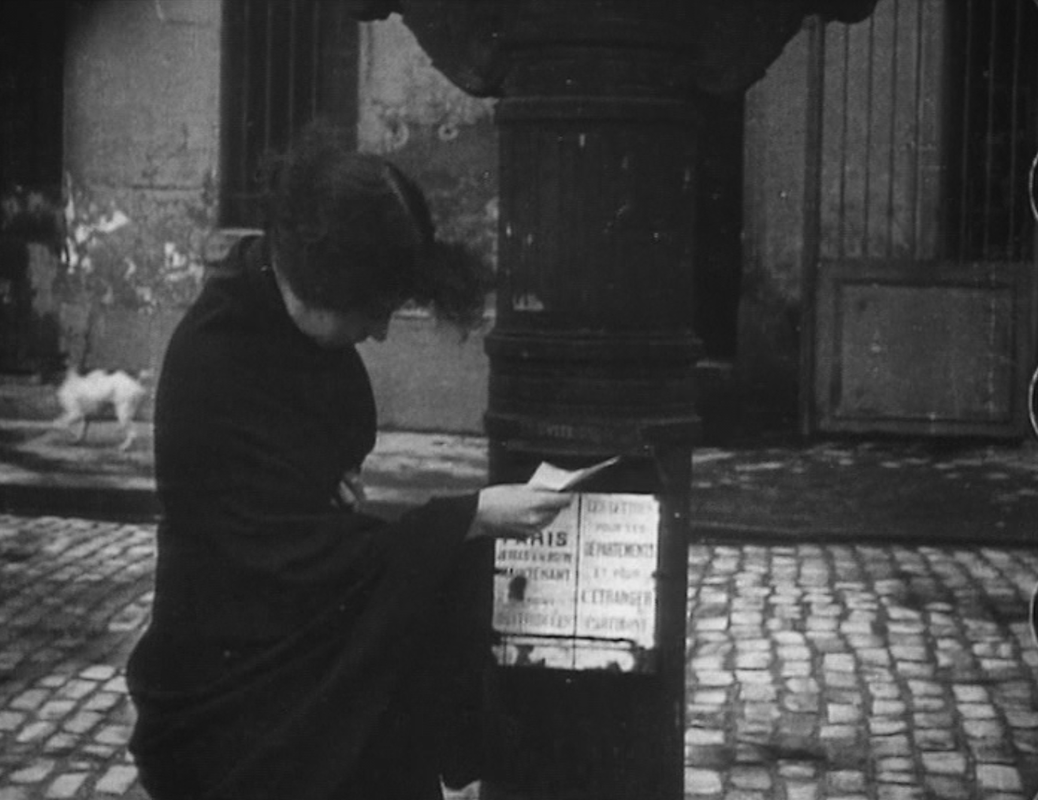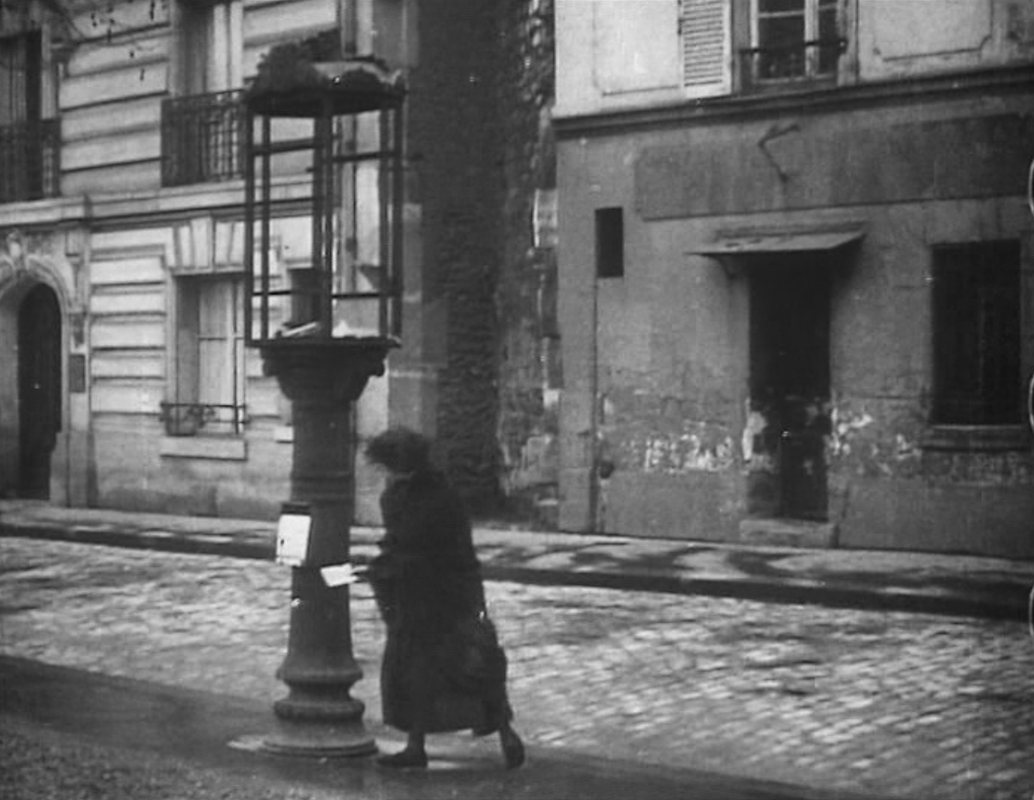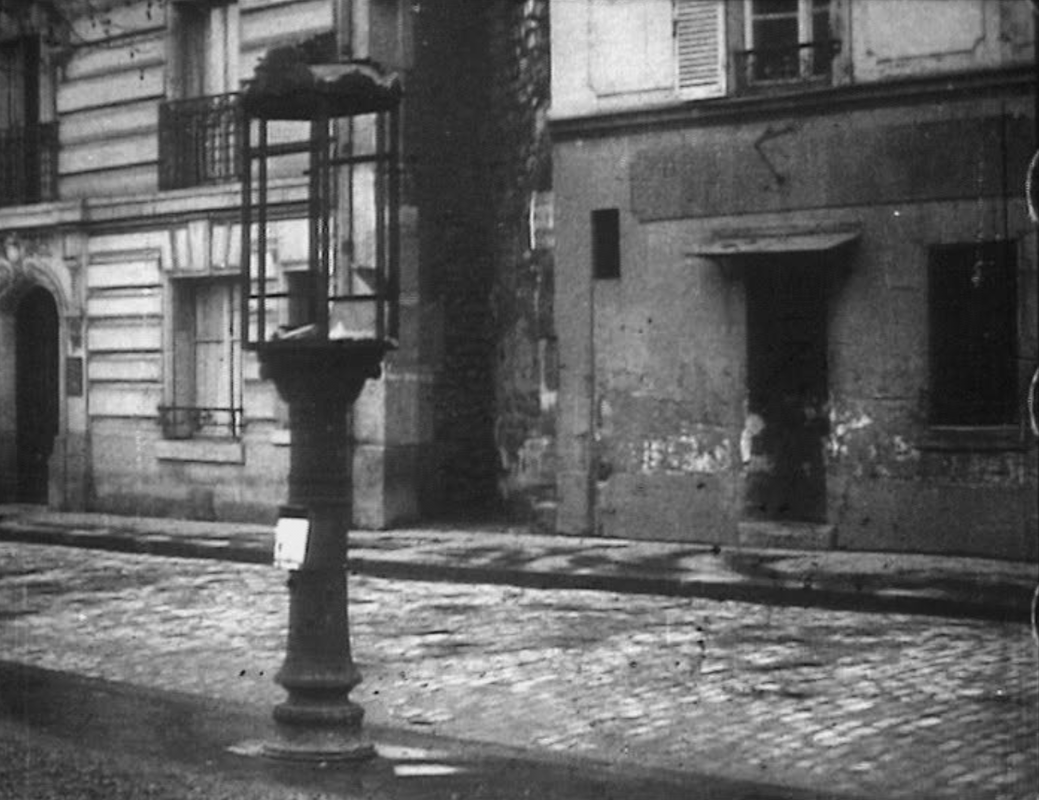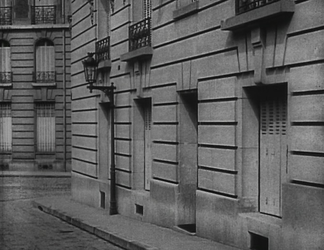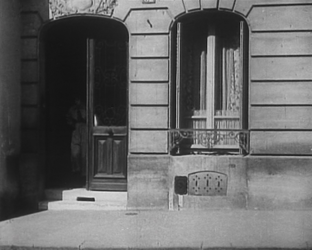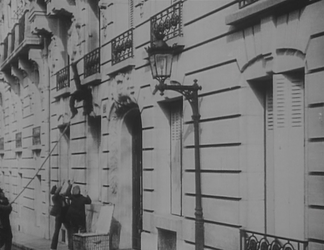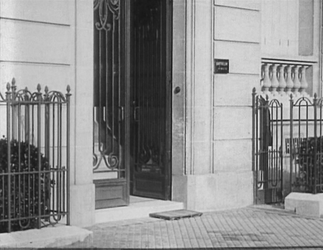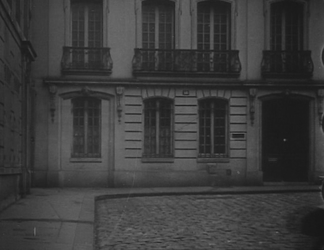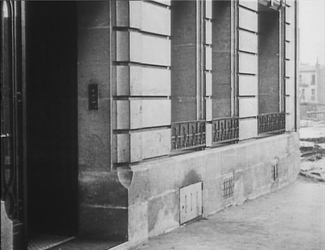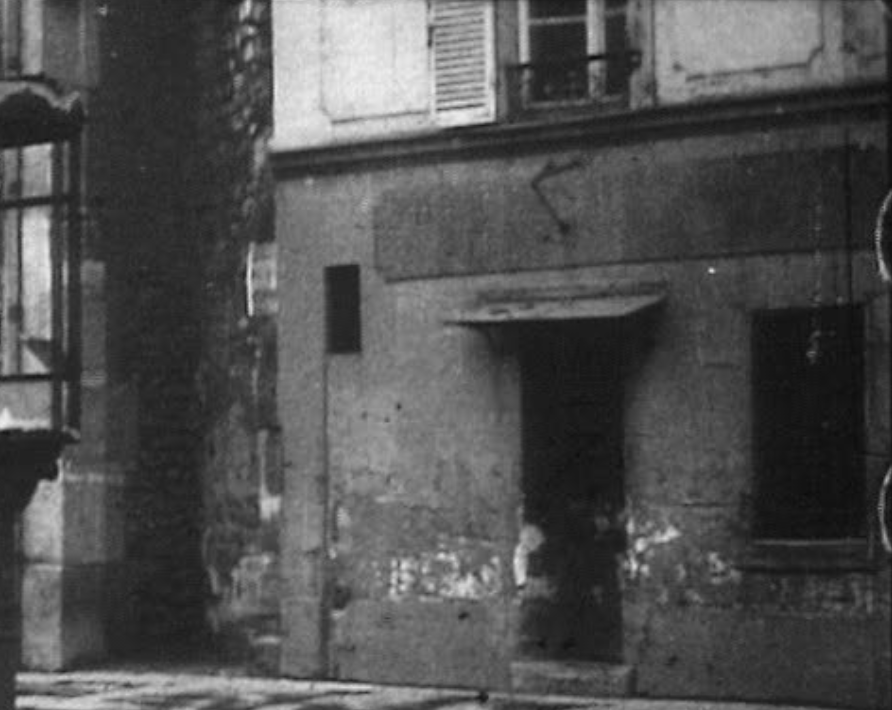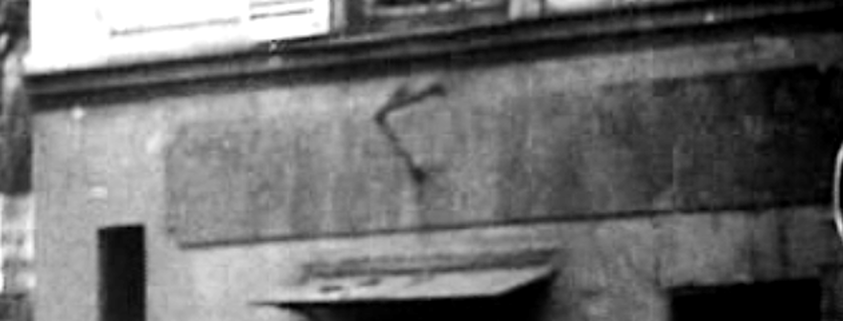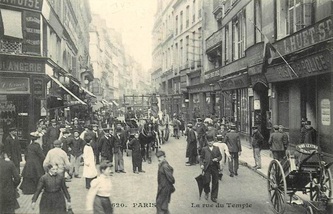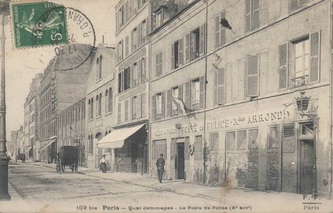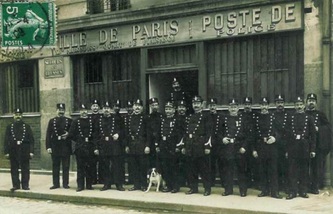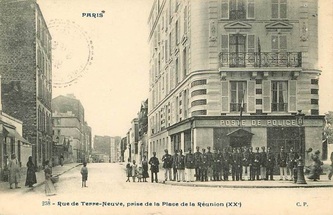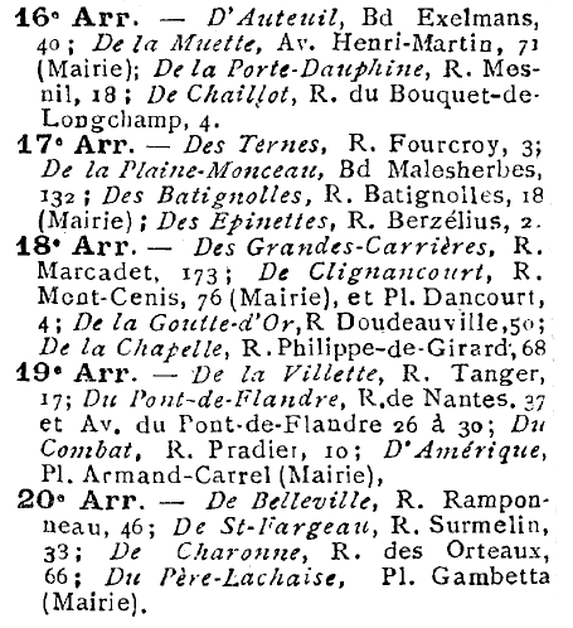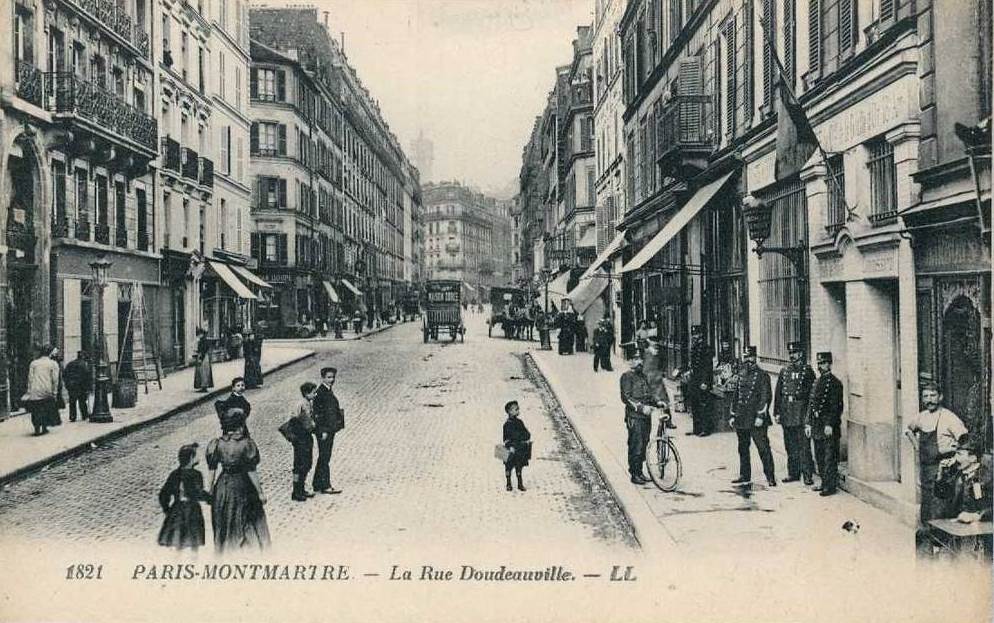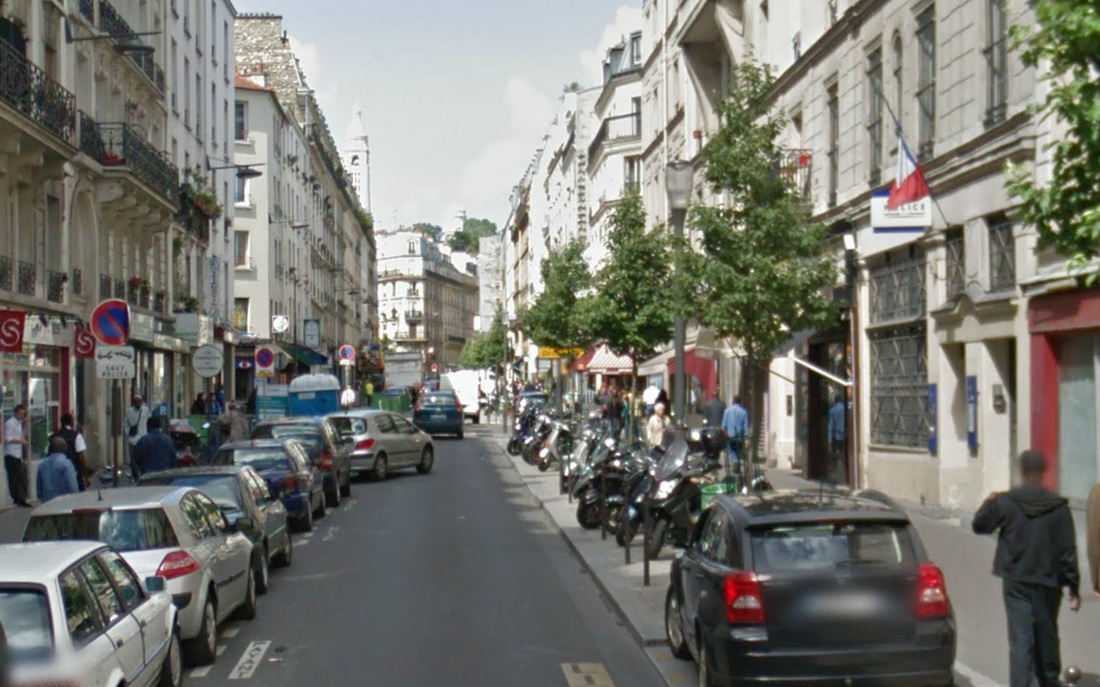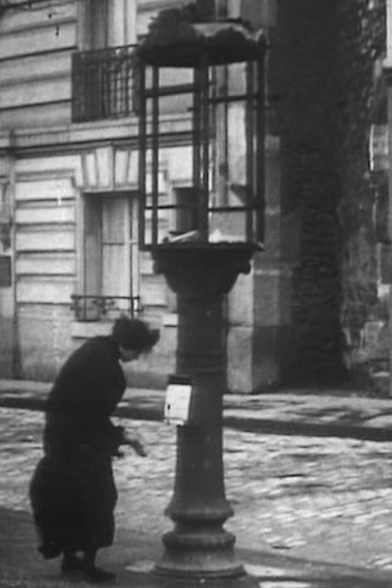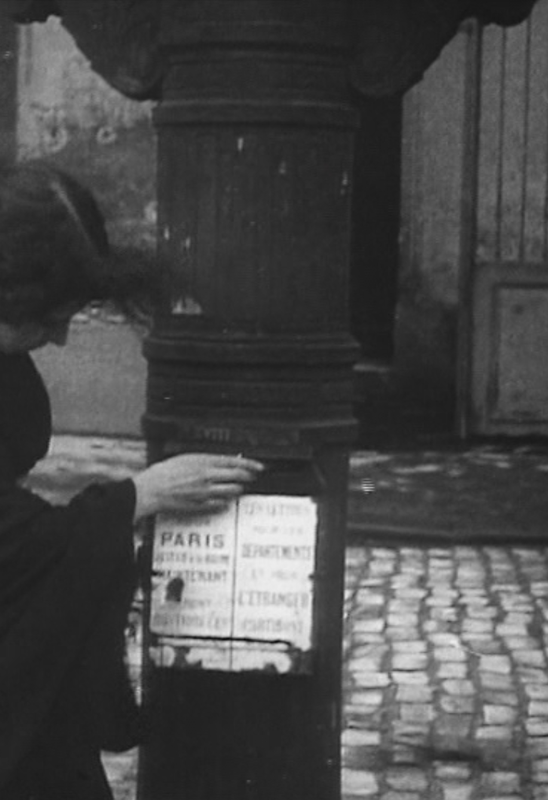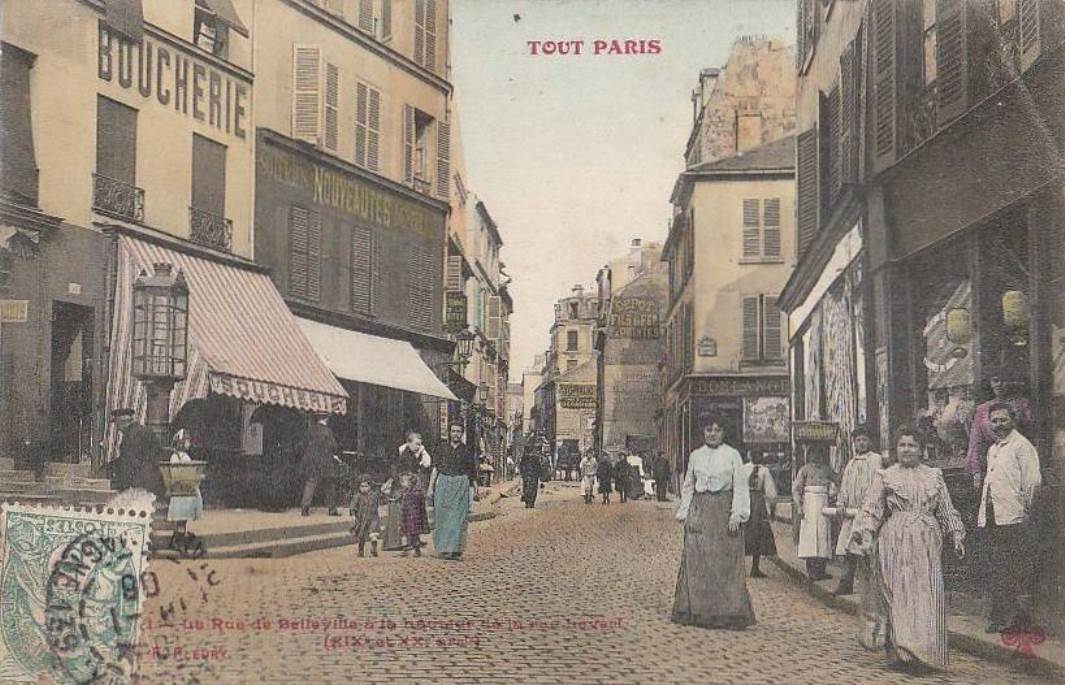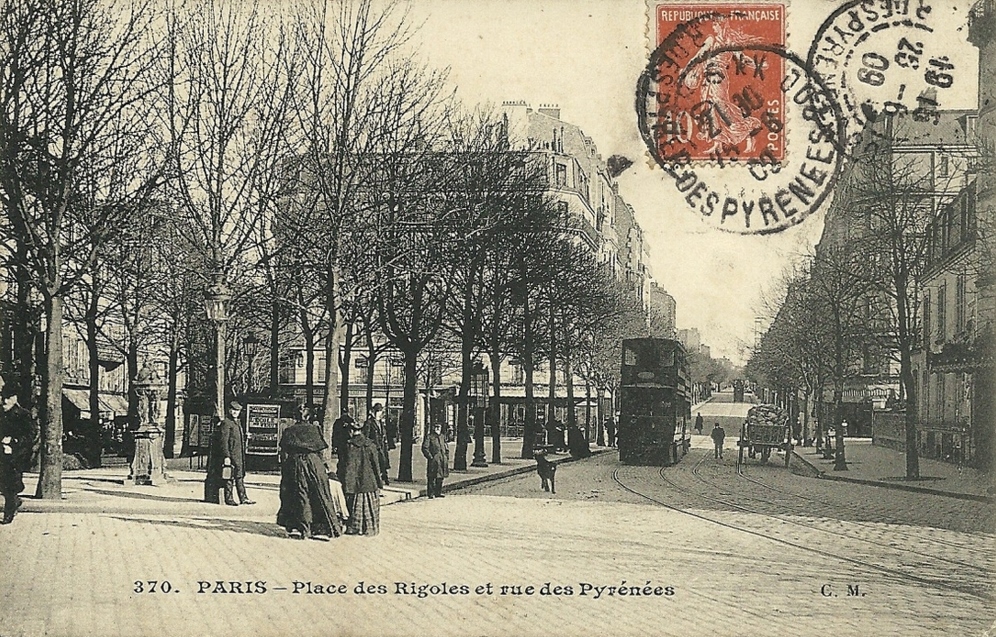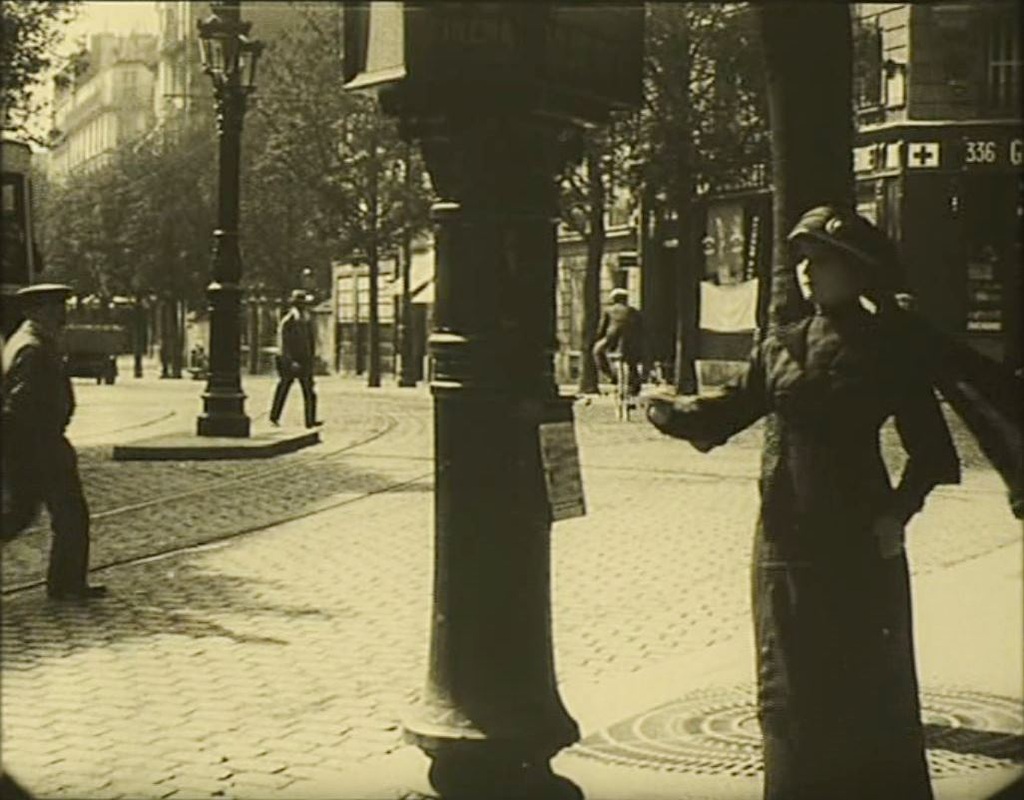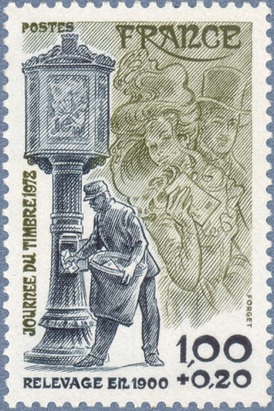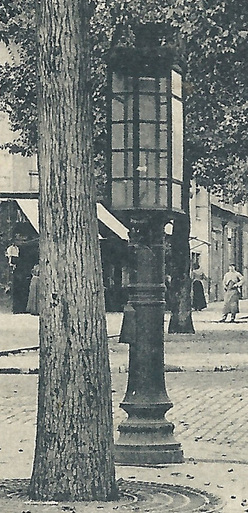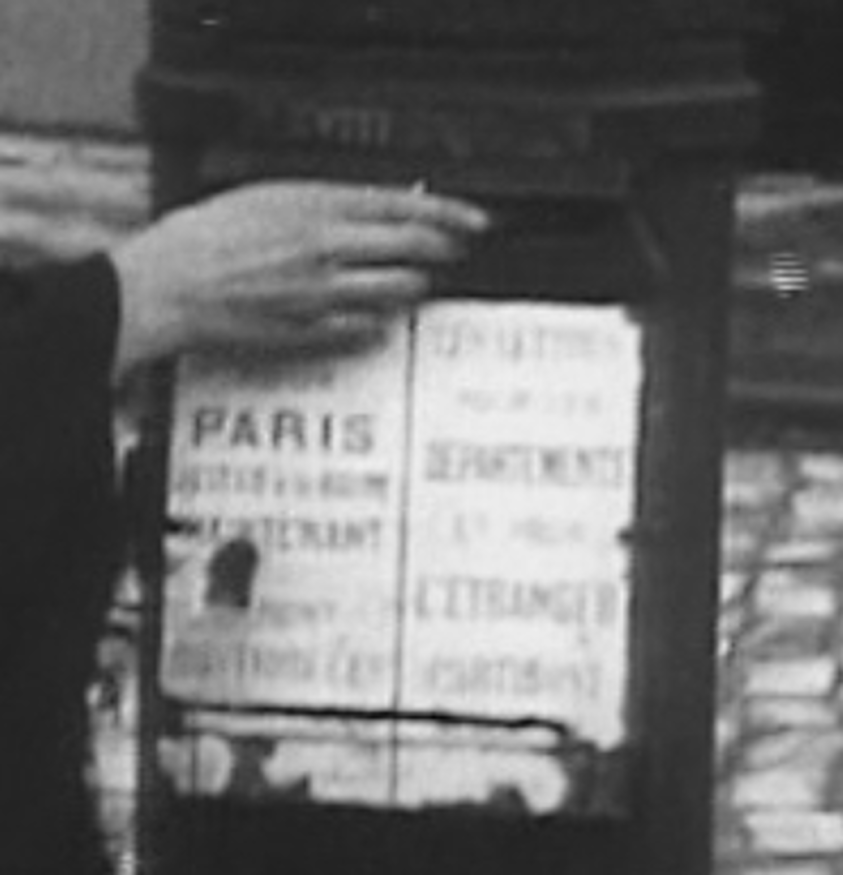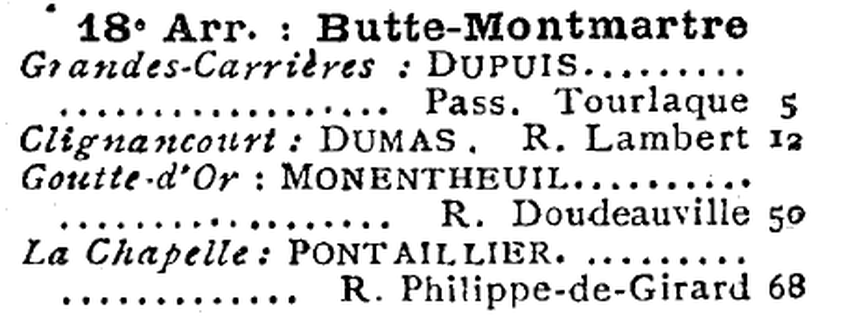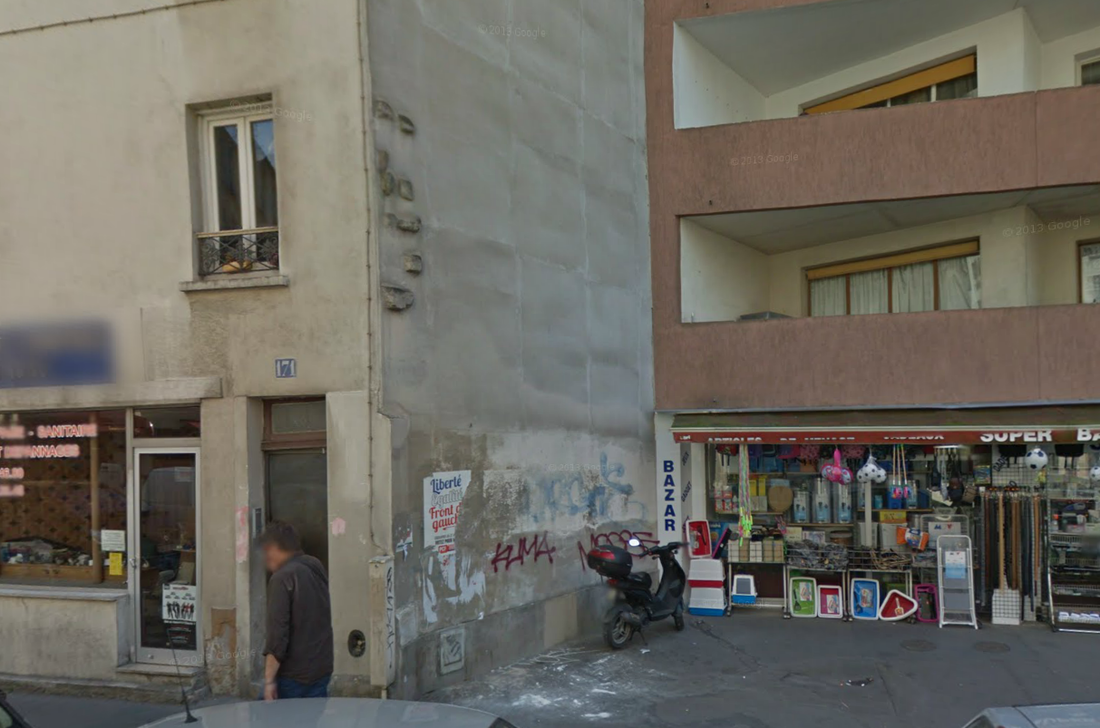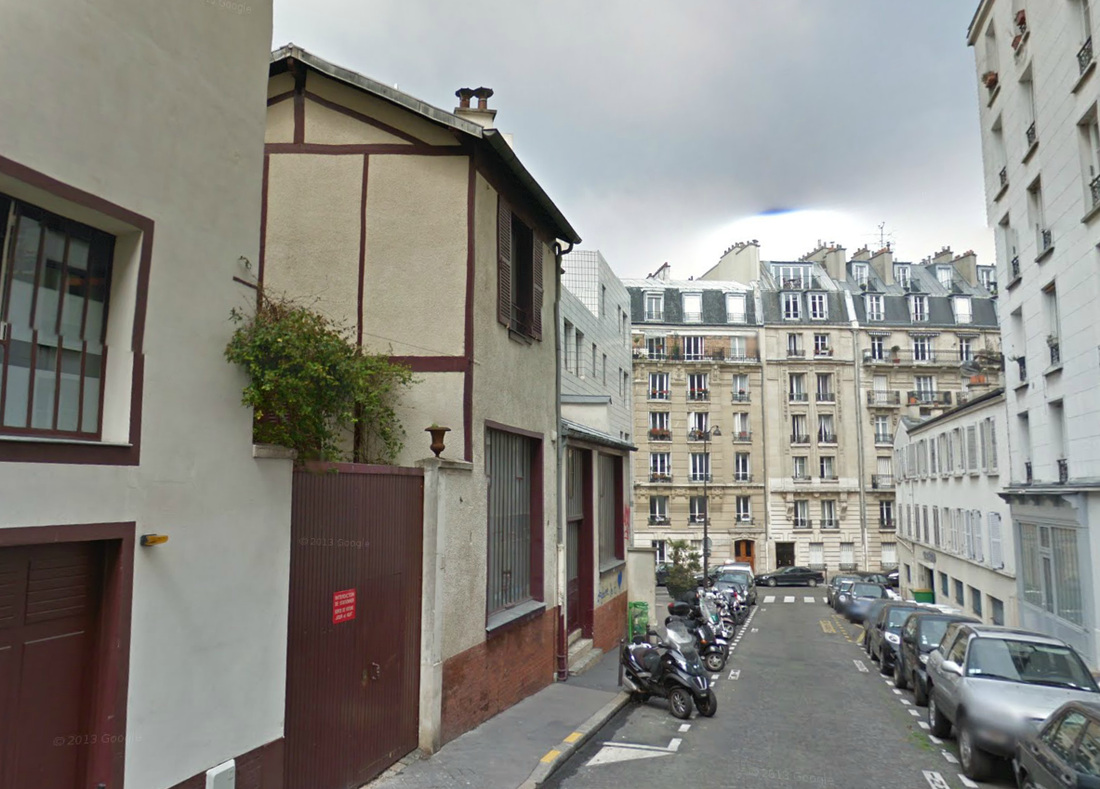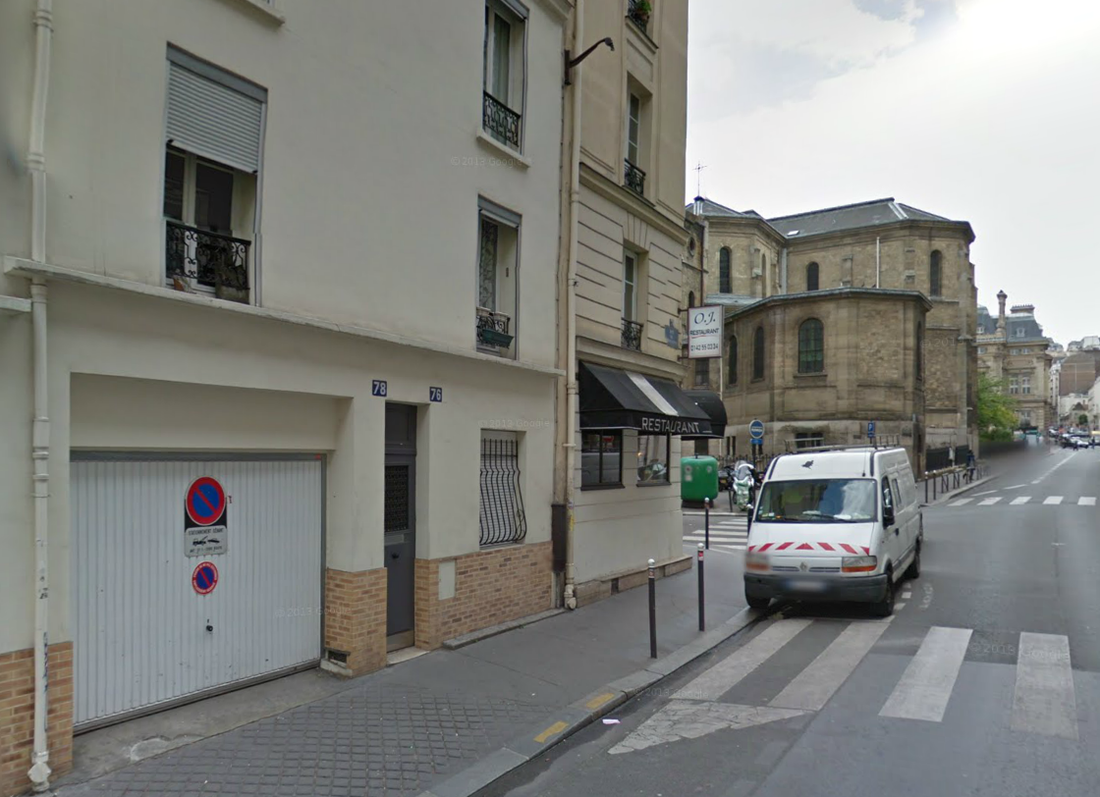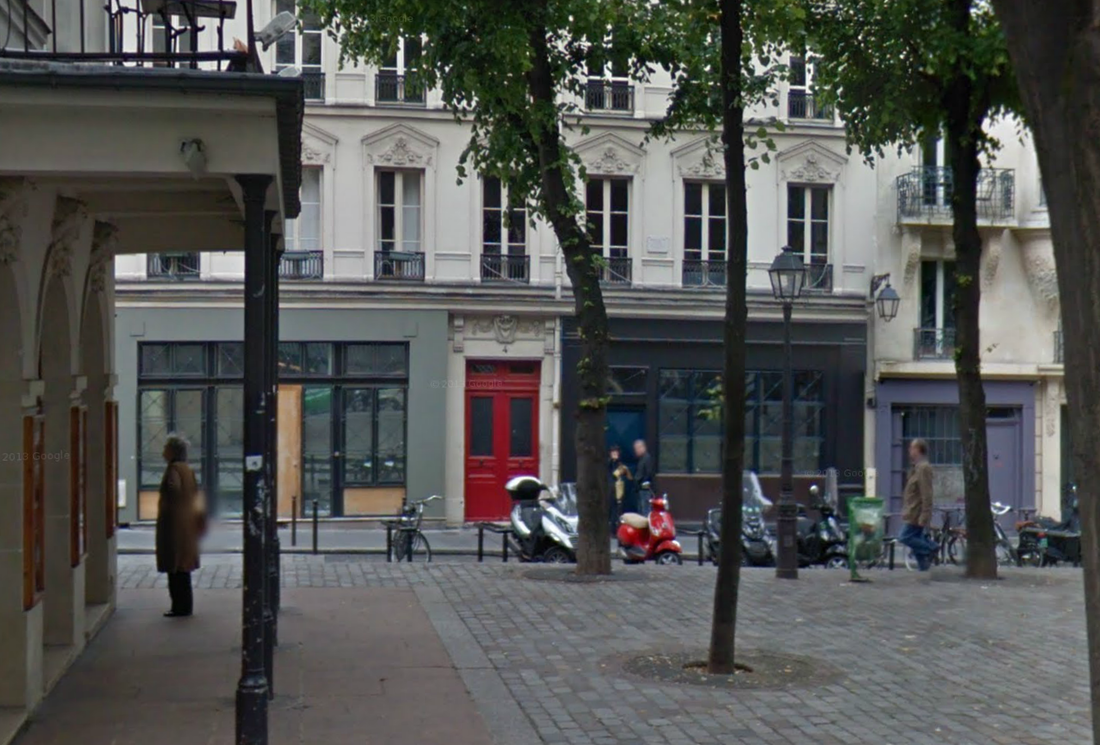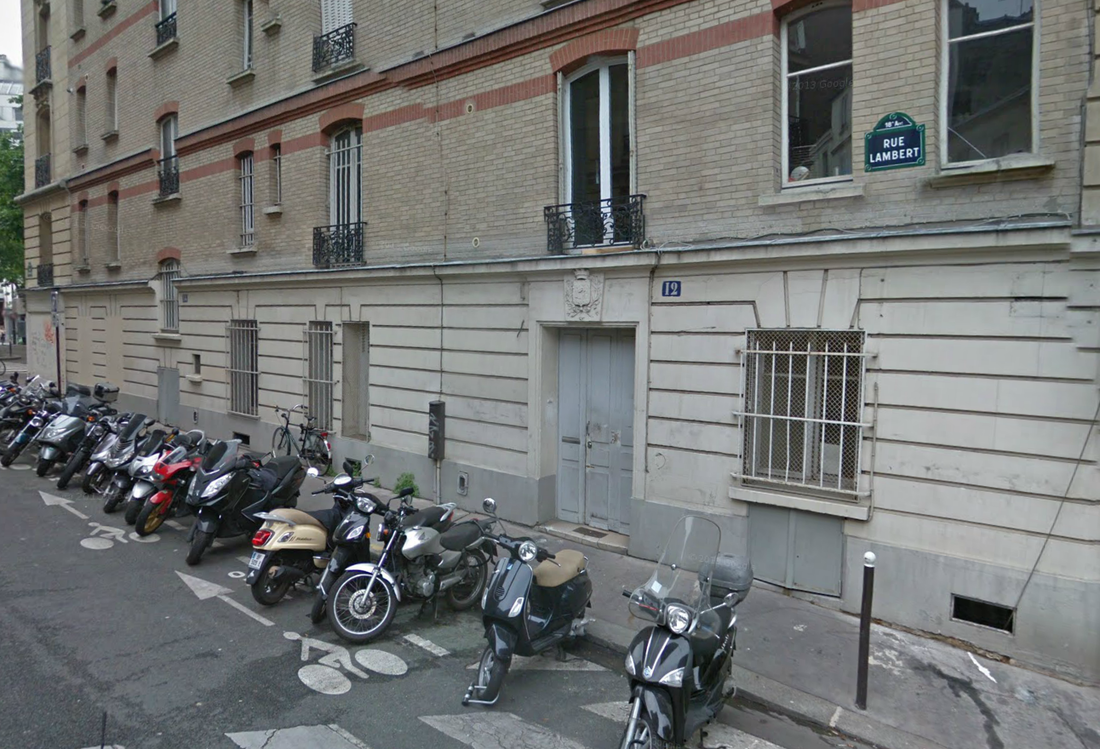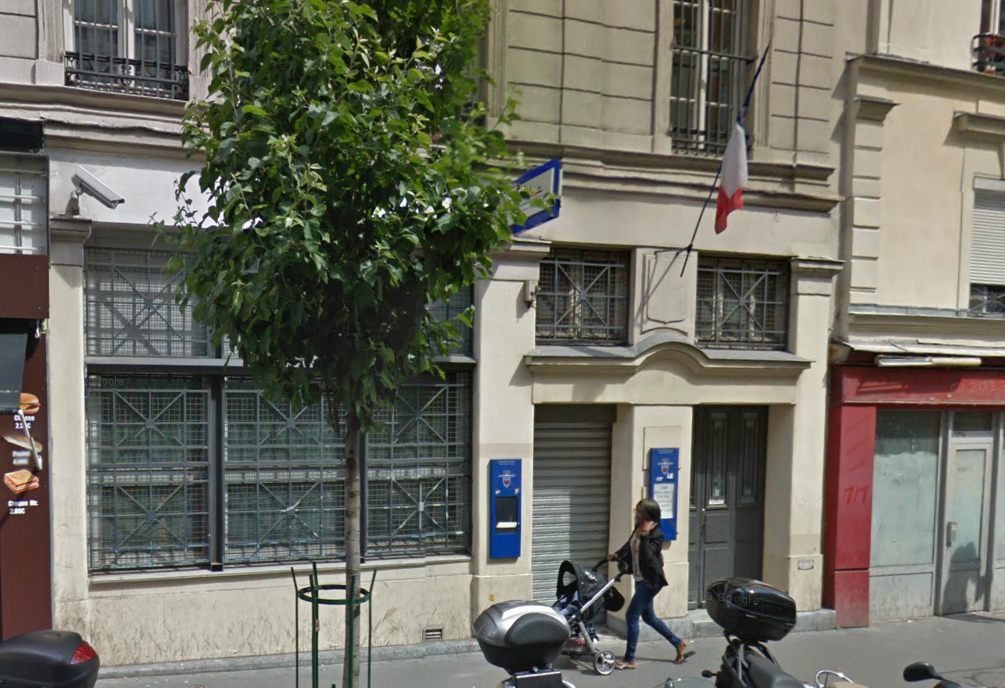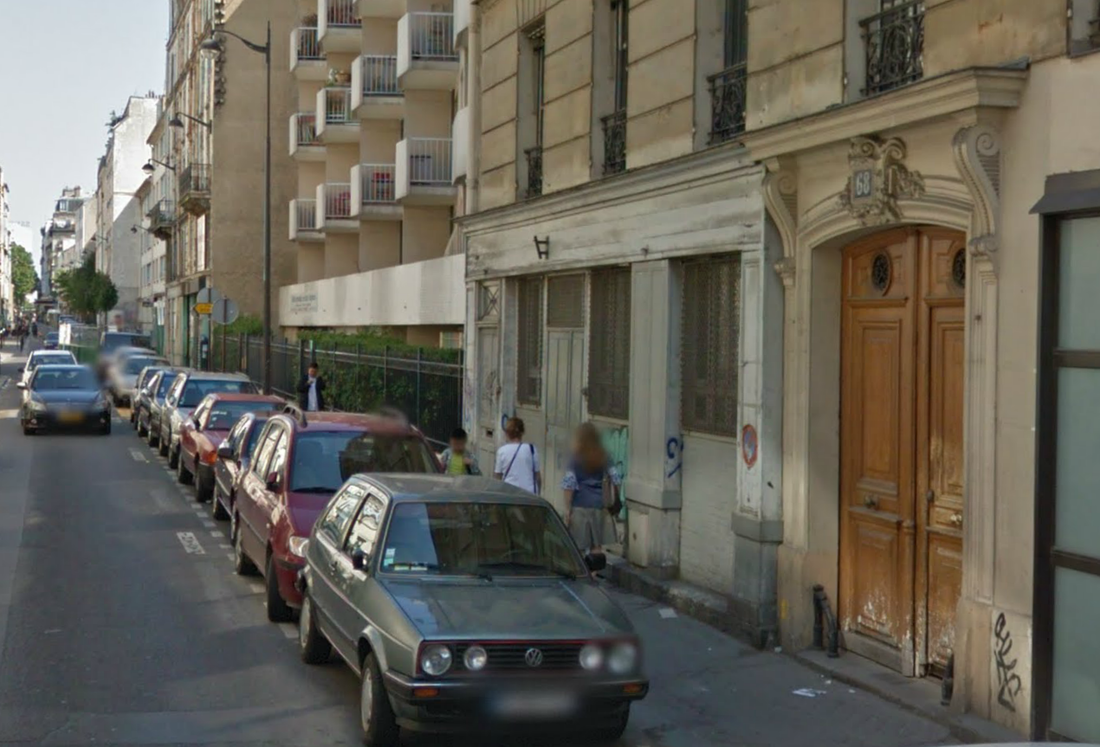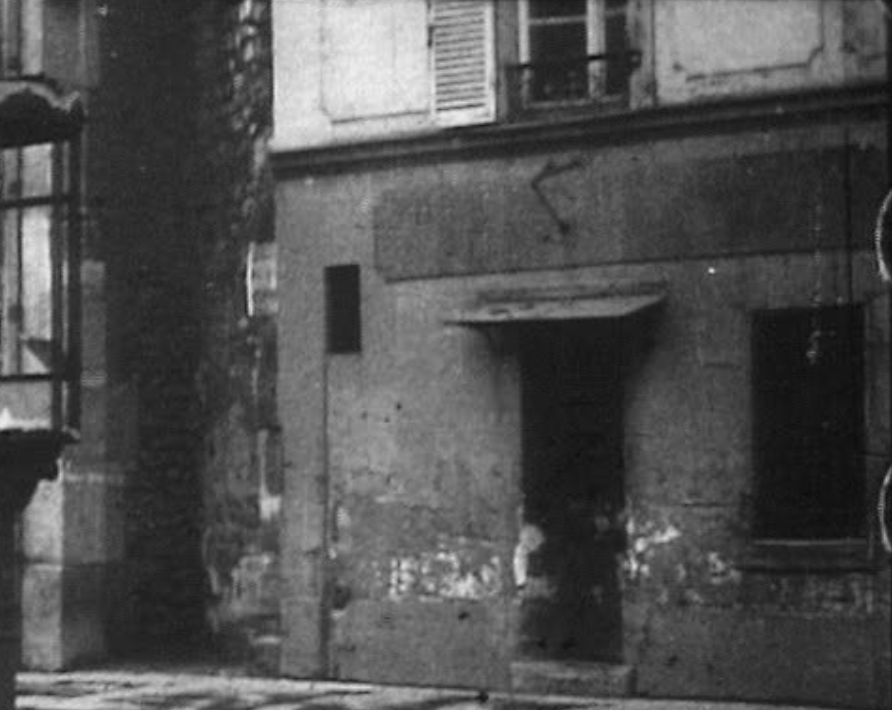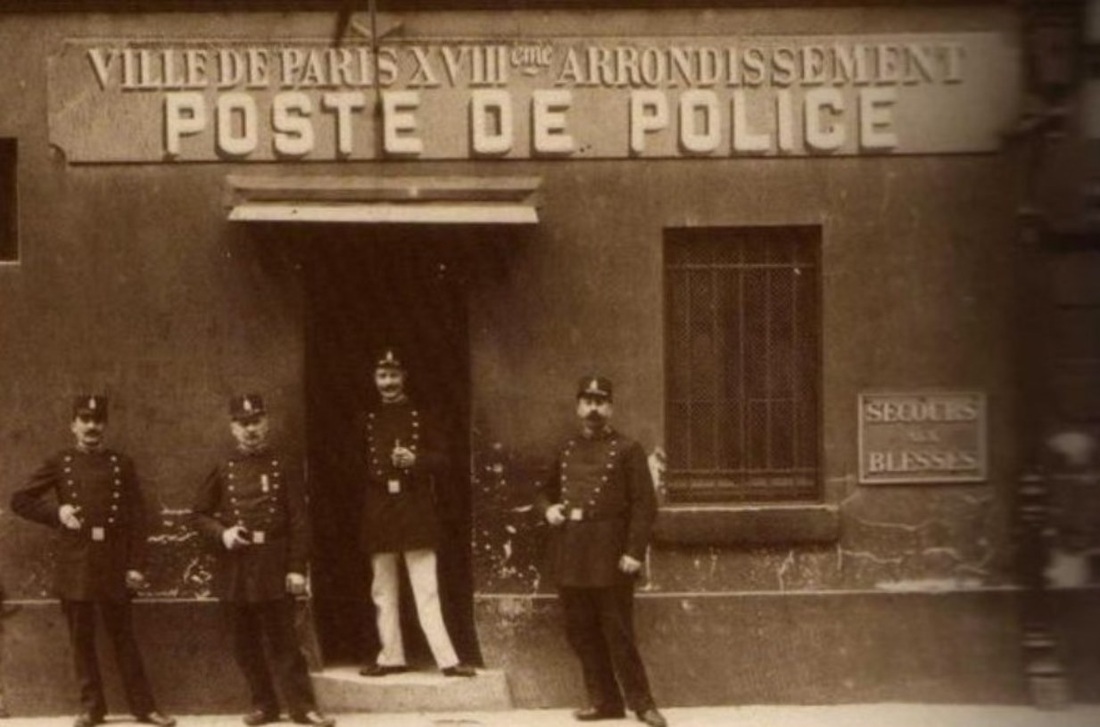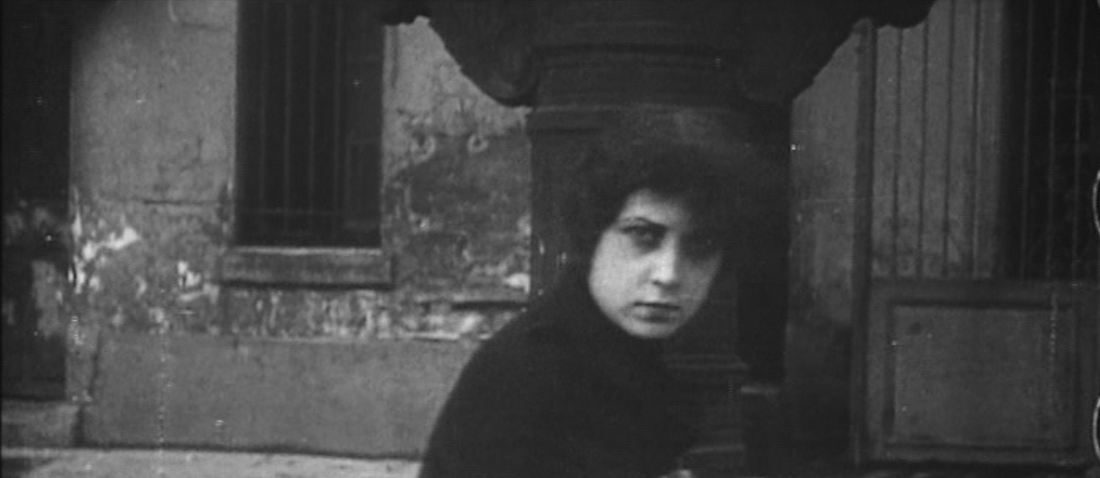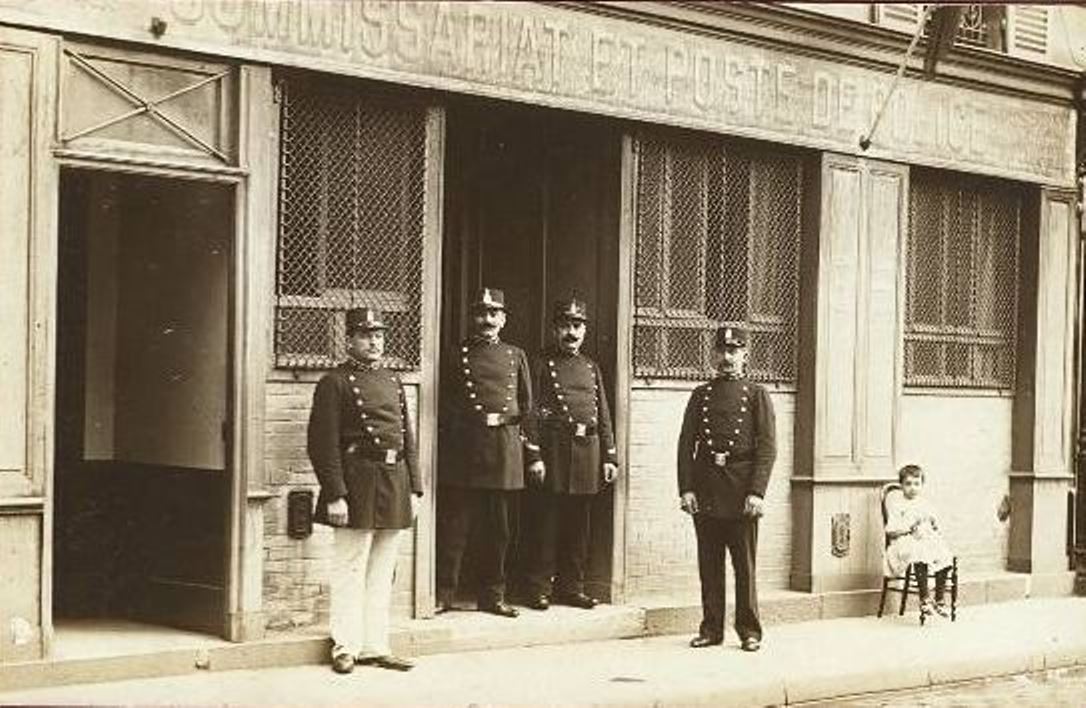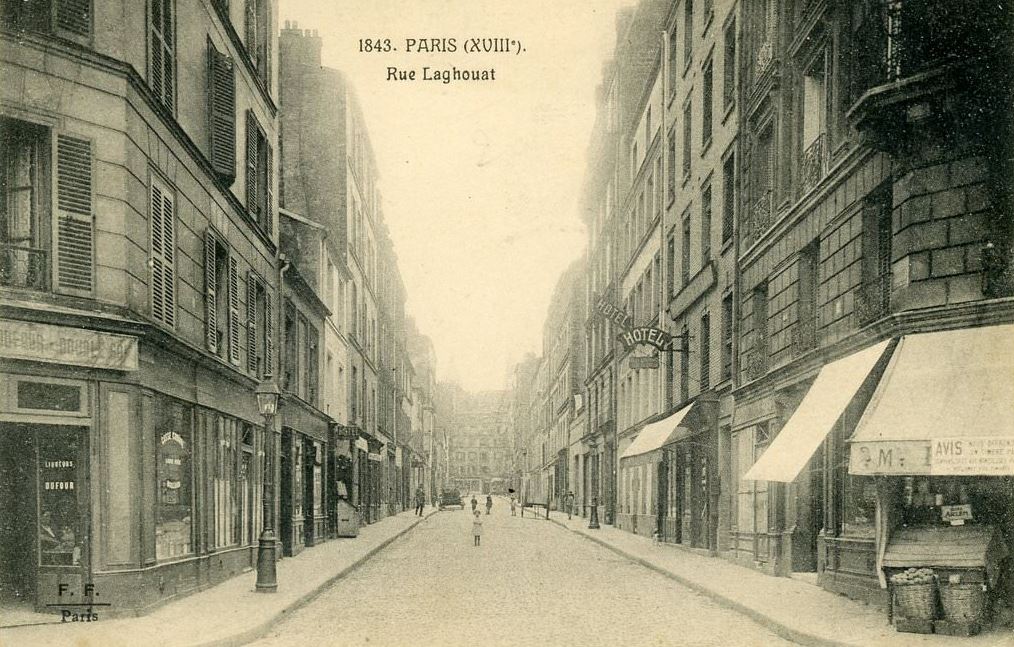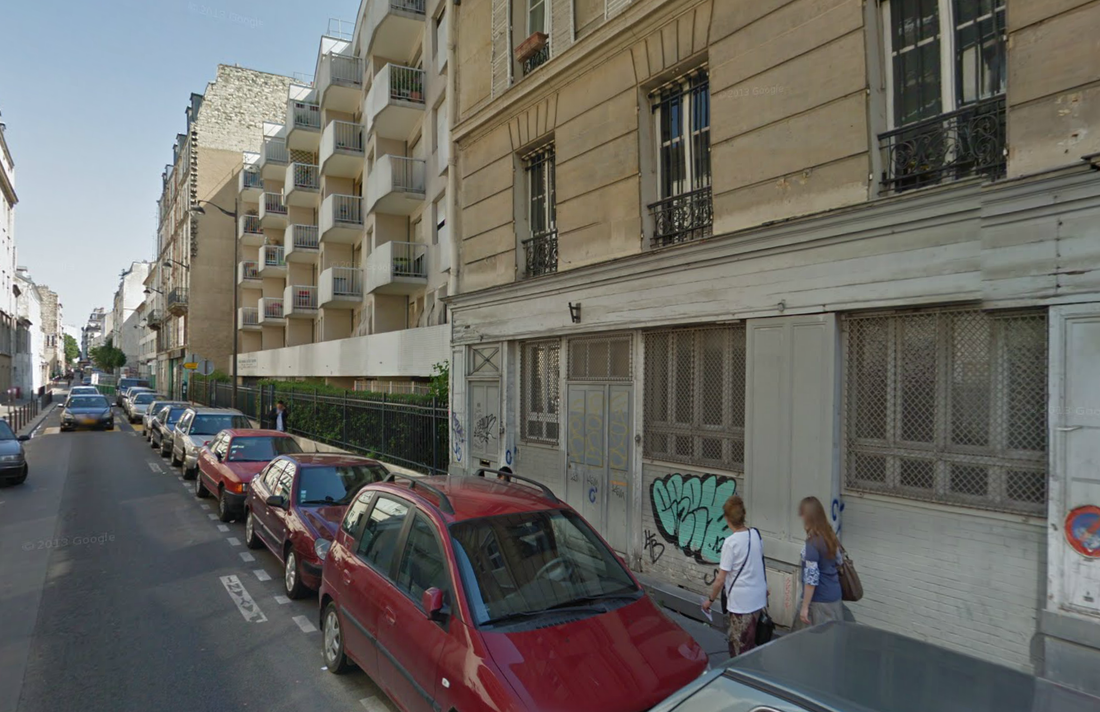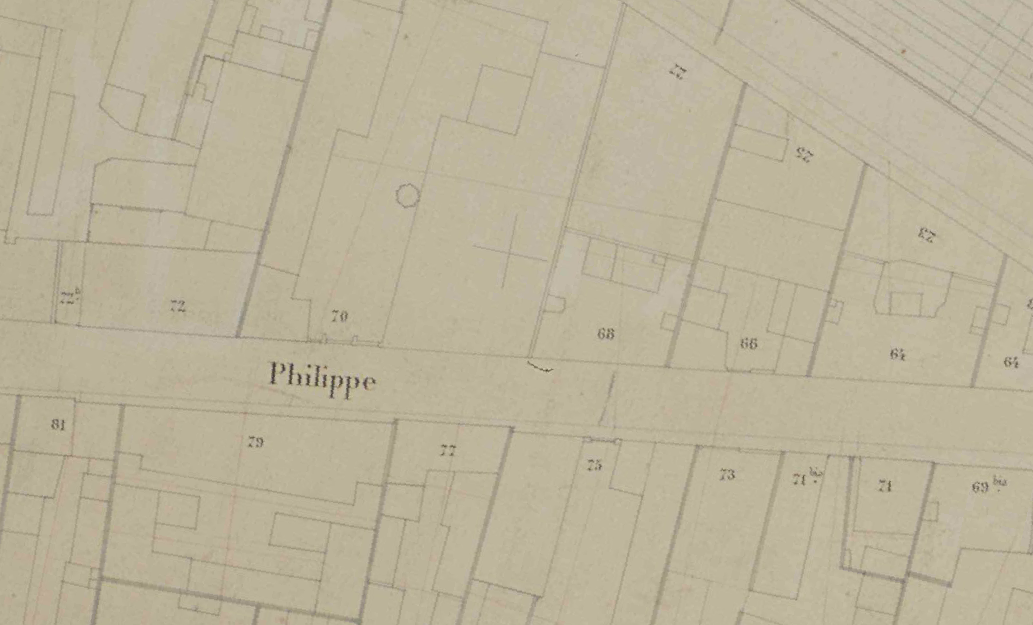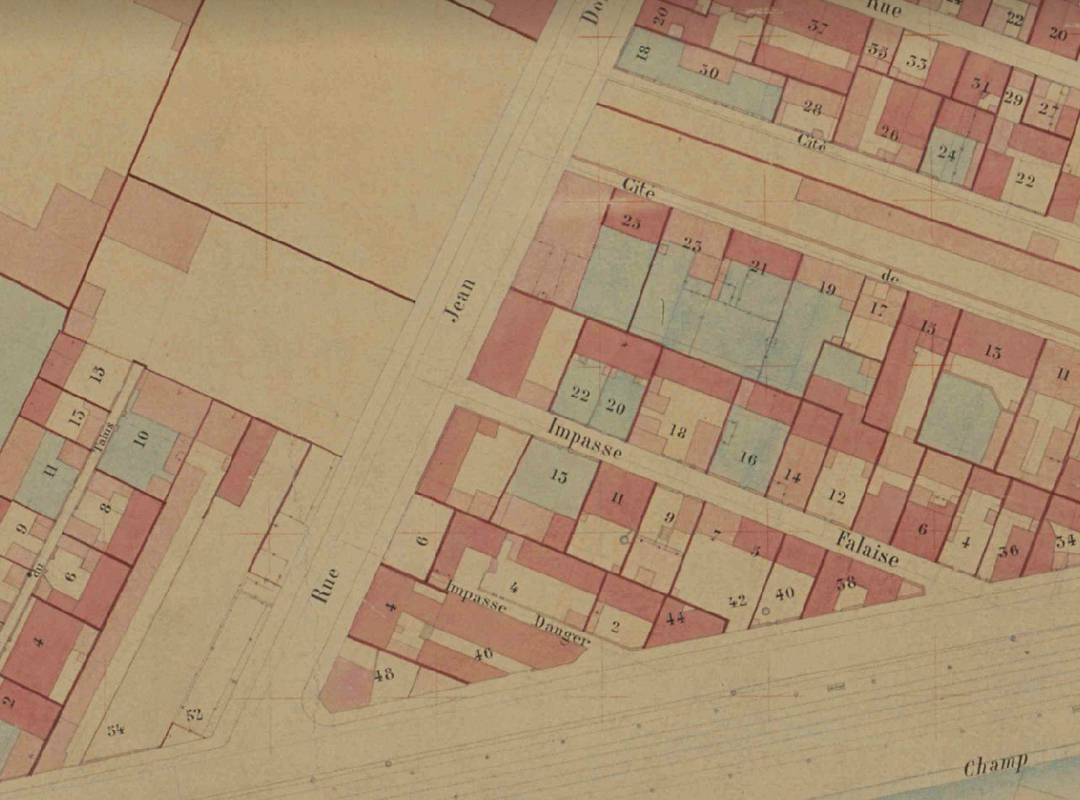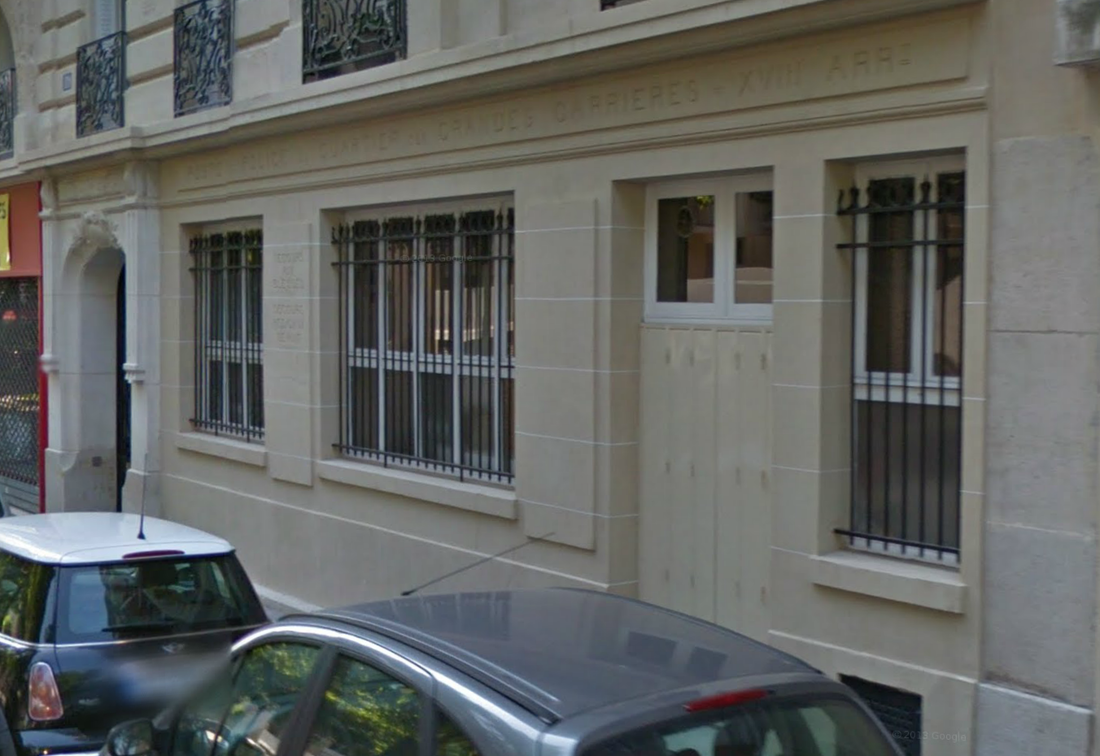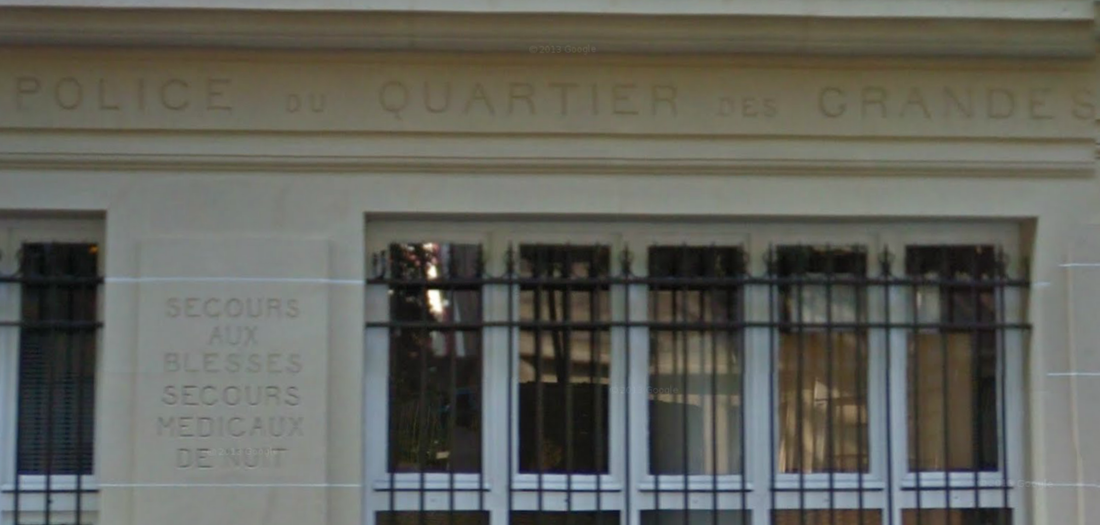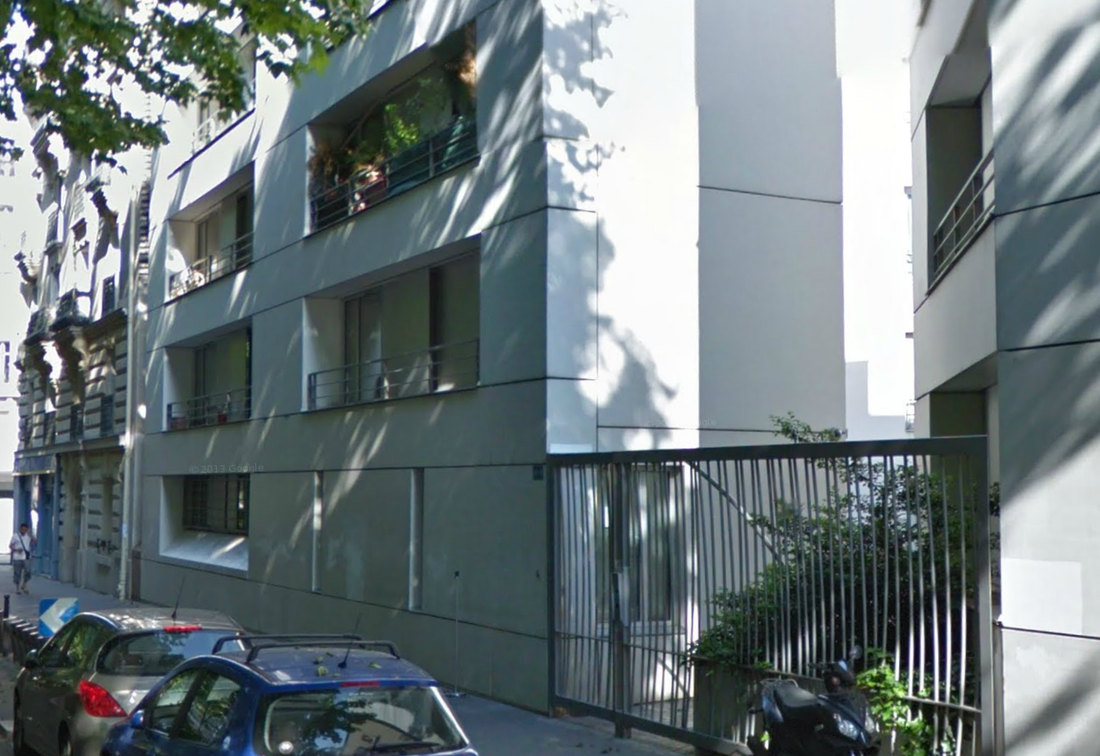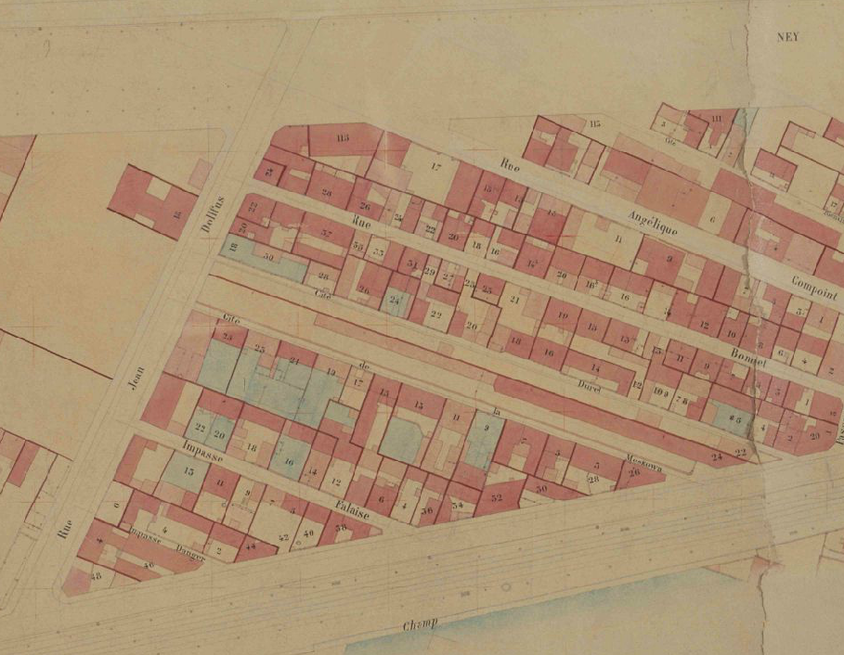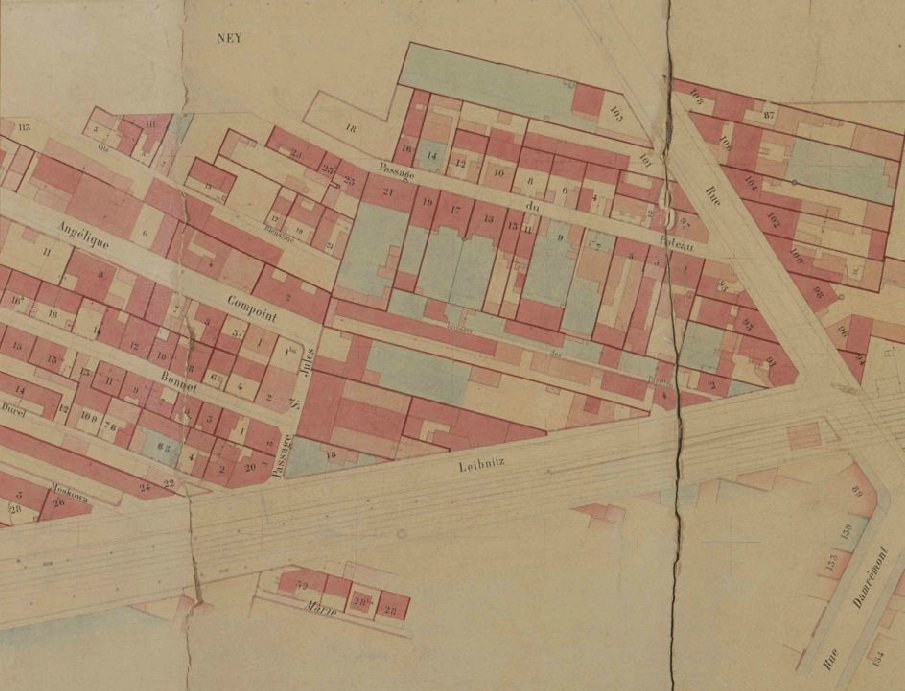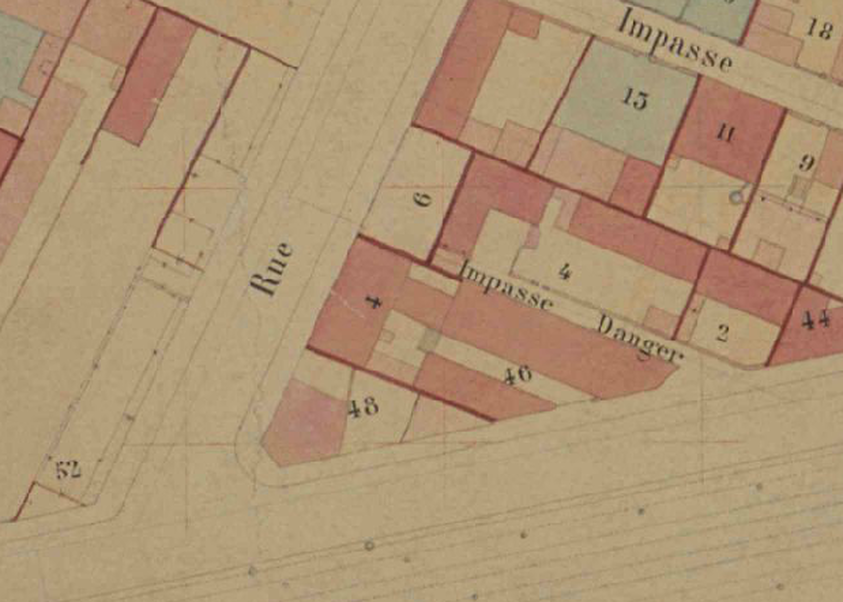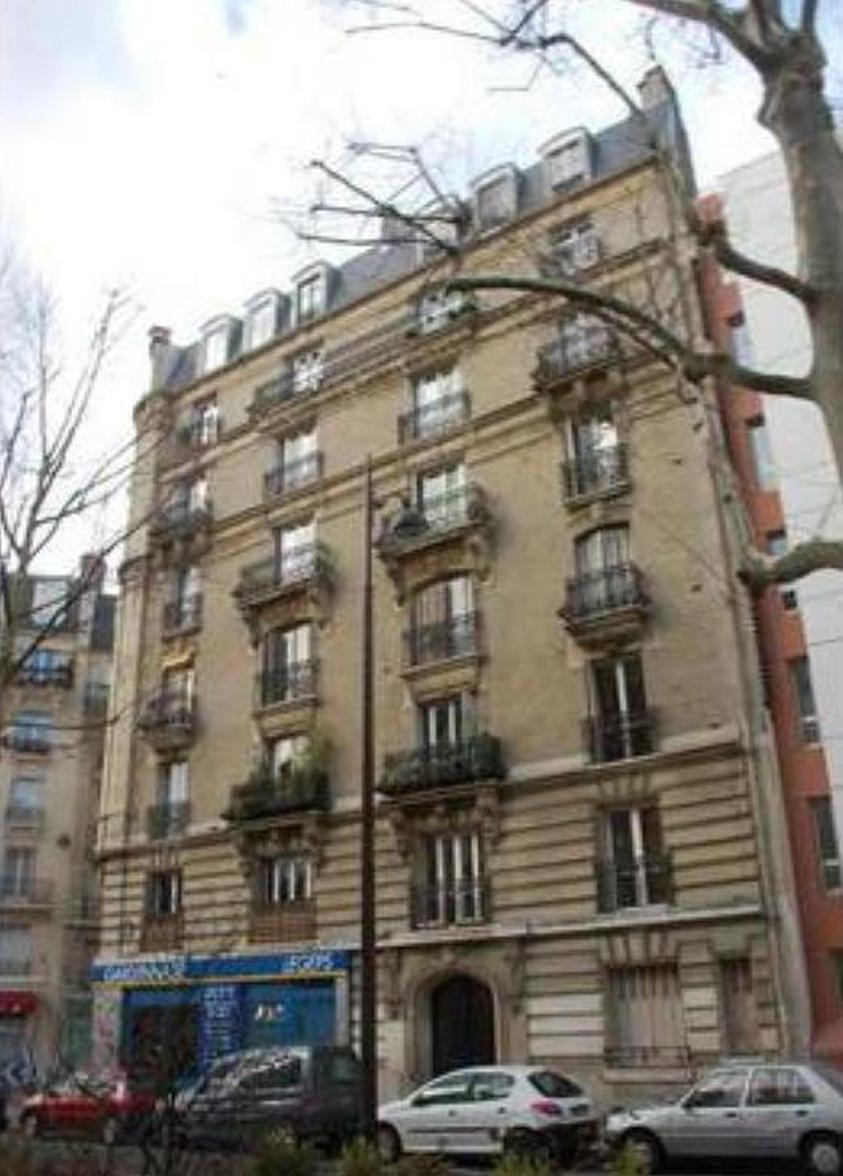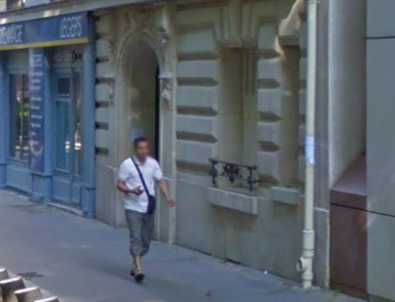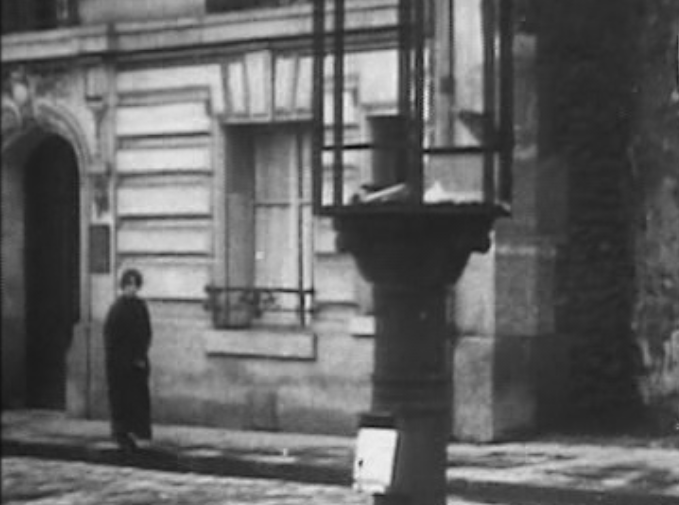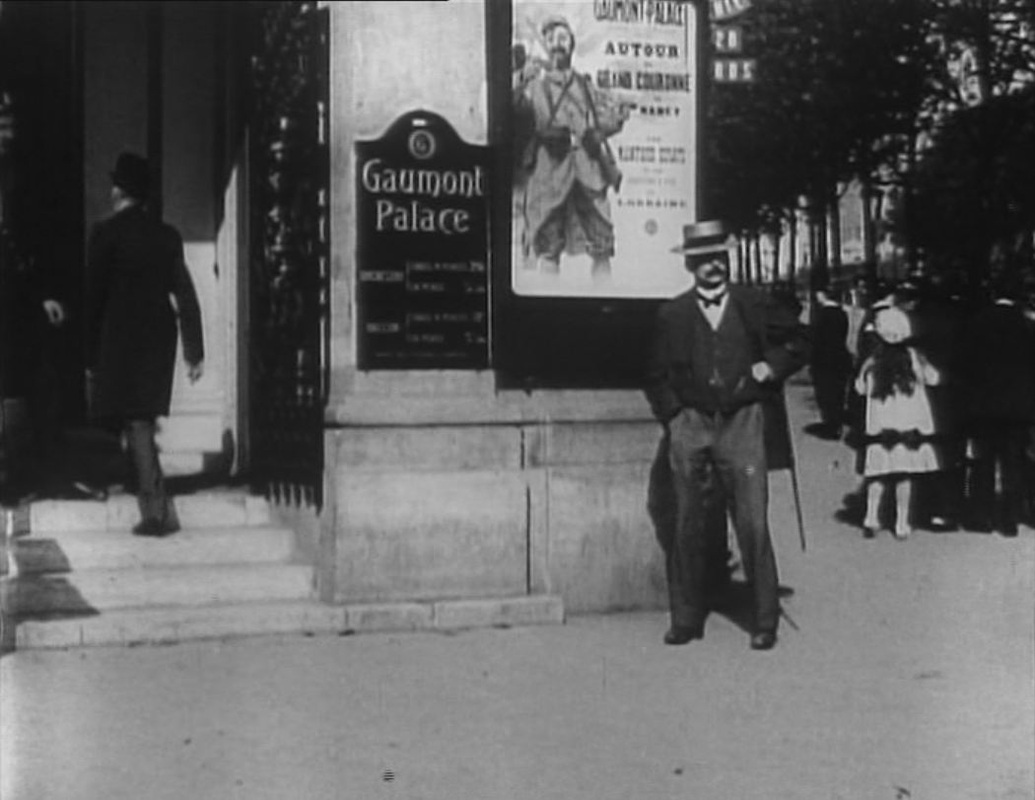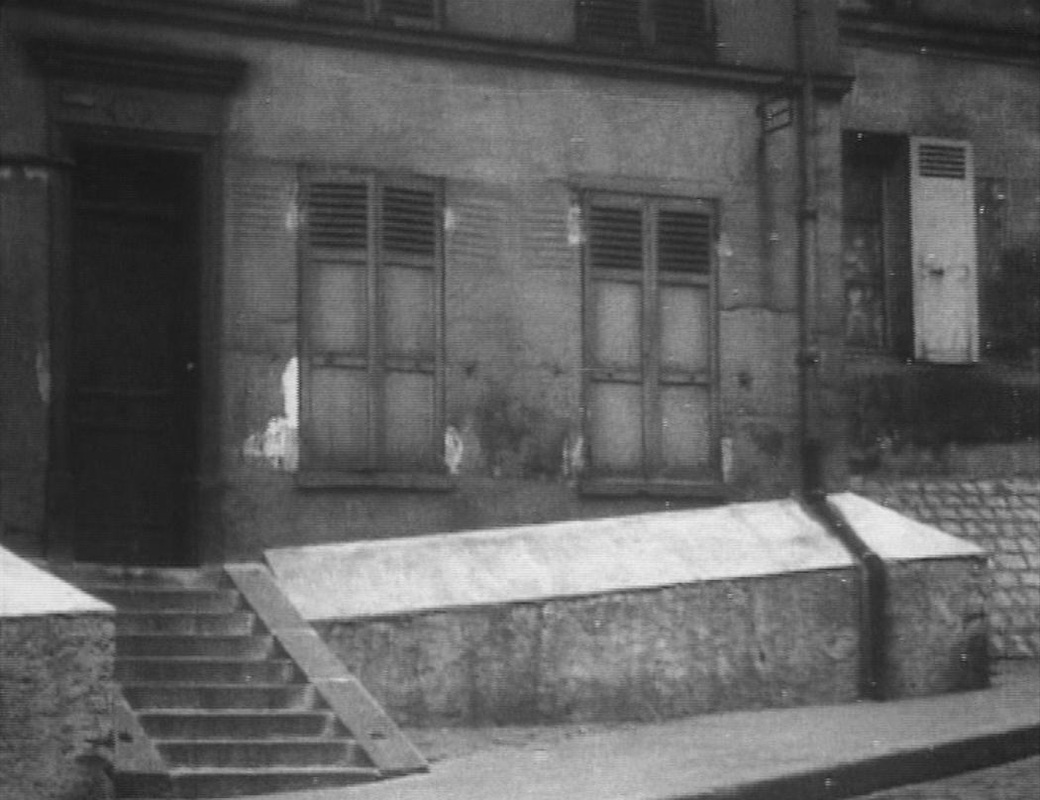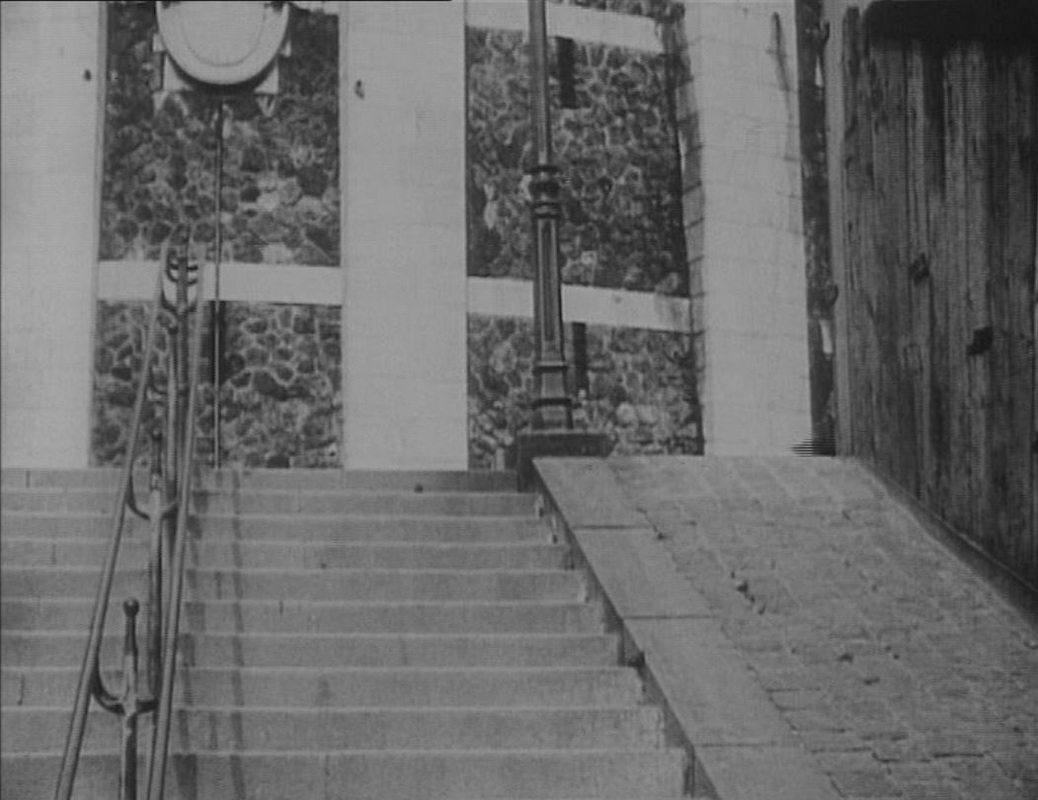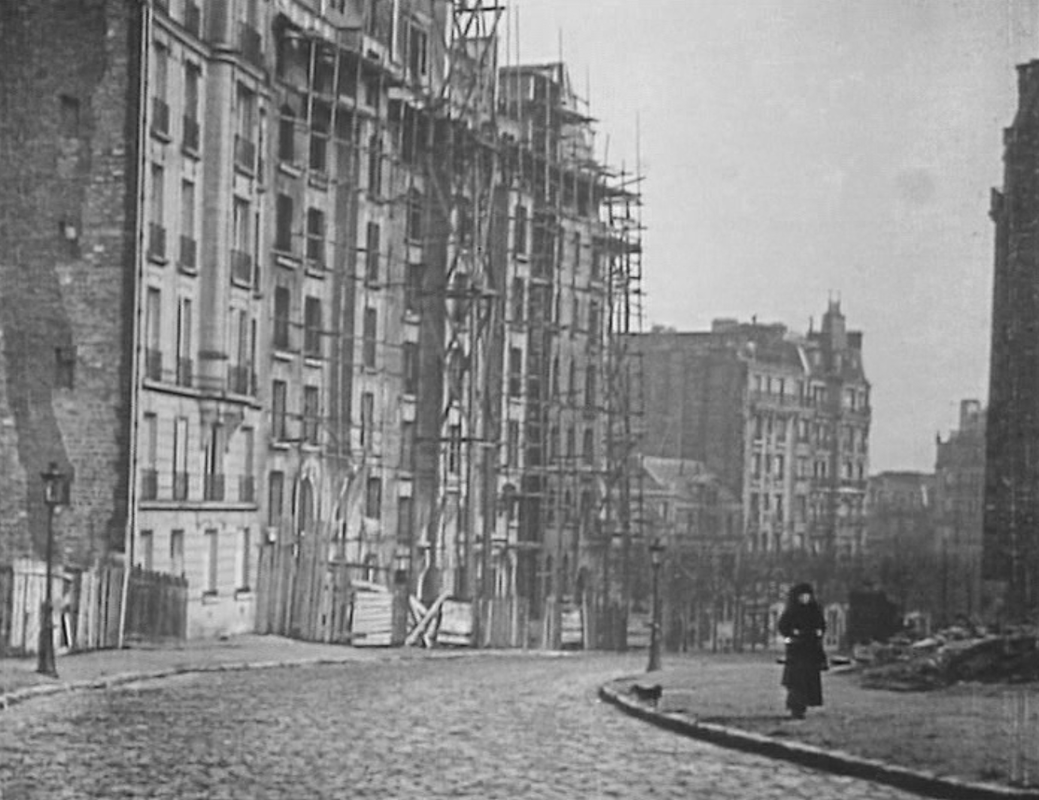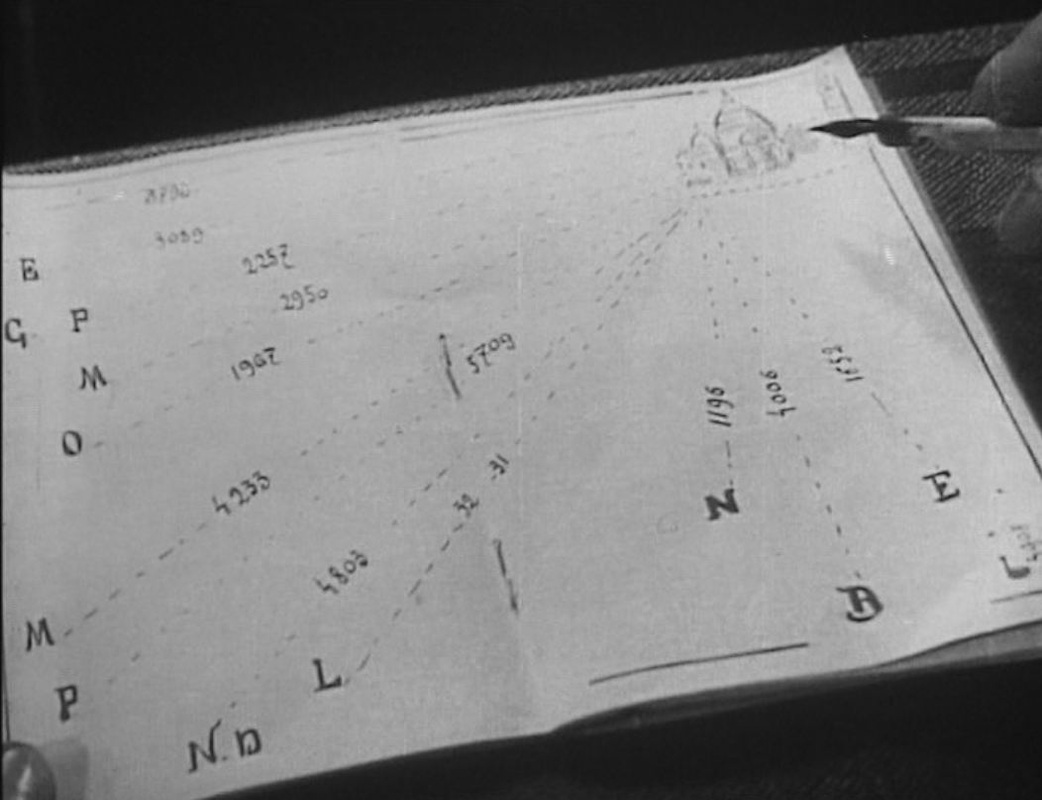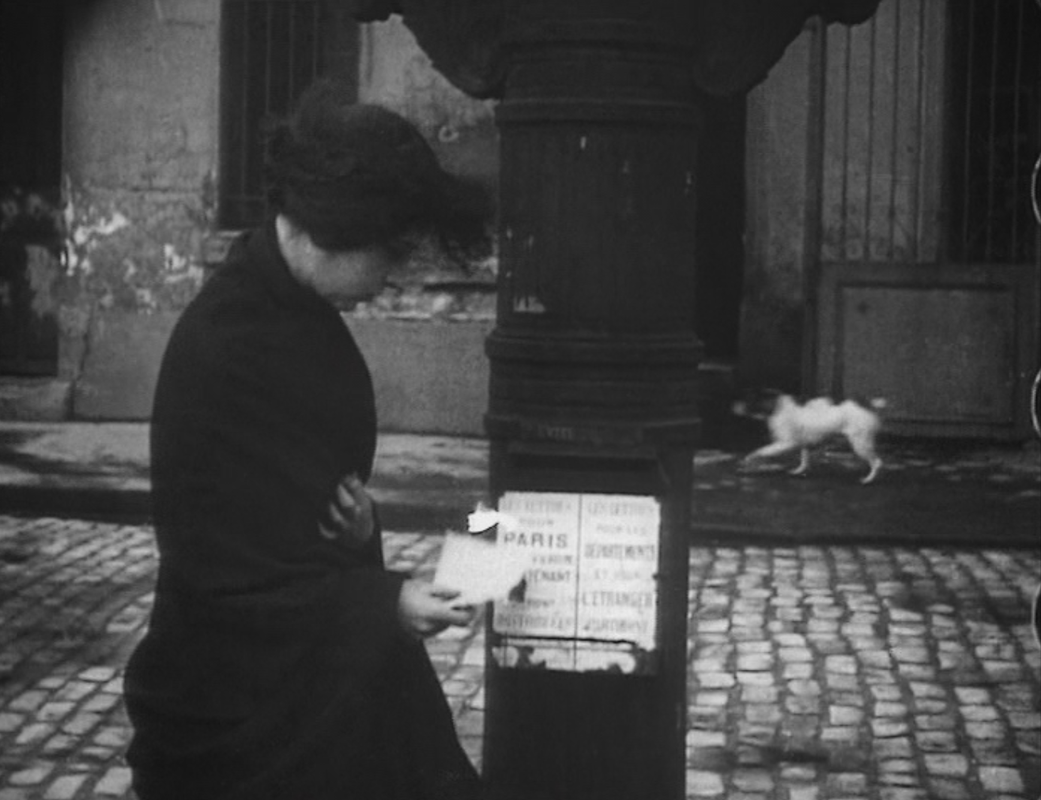Irma Vep posts a letter
(This post comes under the 'narrative of an investigation' heading. It is, depending on your tastes, either a diverting promenade around some unfamiliar parts of Paris, or another laborious probing of inconsequential urban minutiae. If your view is the latter, please feel free to scroll down to the end for the punchline, where I reveal the address of the building in the image above.)
Five minutes from the end of 'Le Maître de la foudre', episode eight of Feuillade's Les Vampires (1915-16), Irma Vep goes out to post a letter. In the previous sequence she had been in conference with Venenos, the new leader of the Vampires now that Satanas is in prison. Venenos gives Irma a letter to post to Satanas, and we then see her do so.
With a little effort and luck it has been possible to find most of the exteriors used in the ten episodes of Les Vampires (a detailed post will come soon), but a few have proved resistant to identification, including the street where she posts the letter:
With a little effort and luck it has been possible to find most of the exteriors used in the ten episodes of Les Vampires (a detailed post will come soon), but a few have proved resistant to identification, including the street where she posts the letter:
The location of this thirty-second, three-shot sequence is only a small part of the grand topographical scheme of Les Vampires, and the process of its identification is described here more as a matter of curiosity than of great importance.
The location has four distinct features that might enable identification: a passage leading onto the street, the two buildings to each side of the passage, and the postbox itself.
The location has four distinct features that might enable identification: a passage leading onto the street, the two buildings to each side of the passage, and the postbox itself.
Most promising of these is the building to the left, with its ornamental doorway and deep-ridged façade, both distinctive enough to enable a match if the building is still standing, a hundred years on. The general look of the building is of course very common in Paris - here are six other instances from Les Vampires:
Identification of such buildings tends to be possible only in combination with other indicators, and in the case of the street where Irma posts her letter that means the building on the other side of the passage:
At first sight this is far less promising. The building already looks run down in 1916, and the chances of its survival are slim. There is, however, a strong clue as to what type of building it was. The panel above the door has writing on it, and though in this reproduction the writing seems indecipherable, when caught in the right light the word 'POSTE' can be made out:
Reference to contemporary postcards shows that this is not a post office but a 'poste de police'. See, below, police stations in four different quartiers across Paris:
None of these is the poste in Les Vampires, but it shouldn't be too difficult, in principle, to track that one down. Each arrondissement is made up of four quartiers, and there is usually one poste per quartier. Here is part of a listing from the 1911 edtion of Paris-Hachette:
That should make a total of eighty addresses to check, though there would actually be a few more than that, since certain quartiers had postes supplémentaires.
These police stations were rarely purpose-built. Rather, the city leased and adapted the ground floor of privately owned buildings for a fixed period and when the lease ran out either renewed it or changed location. Some have been in the same location for over a hundred years. Here are, for instance, then and now images of the station at 50 rue Doudeauville, which opened in 1908:
These police stations were rarely purpose-built. Rather, the city leased and adapted the ground floor of privately owned buildings for a fixed period and when the lease ran out either renewed it or changed location. Some have been in the same location for over a hundred years. Here are, for instance, then and now images of the station at 50 rue Doudeauville, which opened in 1908:
I had started to look at every one of the eighty or so addresses given in the 1911 Hachette directory before realising that it was possible to narrow the field of the search considerably, just by looking more closely at the postbox:
This is a postbox of a peculiar type, known as a colonne postale or colonne Dufayel. The letters go in half way up the column, but the function of the upper part is somewhat mysterious. It becomes clearer in this example, where we see that the upper part carries advertising:
There is no advertising on the postbox in Les Vampires, and at first I thought this meant it had fallen into disuse, but here is a picture of the postbox above, this time like Irma Vep's postbox, just a frame:
It is less clear that in the photograph below the postbox is also unadorned, but I wanted to show it because it is one that appears in an earlier letter-posting scene by Feuillade, in episode three of Fantômas:
A long and richly illustrated discussion of this object on CPArama, a postcard collectors' forum (see here), fills in the detail of its history. In 1894 the city sanctioned the installation across Paris of these hybrid constructions. The upper part was gas lit, illuminating the advertisements from inside so that they could be seen at night.
|
The chief concessionary for these was the department store owner and retail entrepreneur Georges Dufayel, hence their common appellation.
|
The colonne Dufayel is a forgotten part of Parisian street furniture, though it was commemorated on a postage stamp in 1978.
I digress. When I said that looking closely at the postbox would narrow the field for finding where we are, I meant something different.
Above the opening for letters are the numerals 'XVIII', telling us that we are across the street from a poste de police in the eighteenth arrondissement:
I digress. When I said that looking closely at the postbox would narrow the field for finding where we are, I meant something different.
Above the opening for letters are the numerals 'XVIII', telling us that we are across the street from a poste de police in the eighteenth arrondissement:
There should be four possibilities, then, though as you can see below the Hachette directory lists five, because in the place Dancourt there is a poste supplémentaire:
In every quartier there is also a commissariat, with different functions allotted, though sometimes it is located at the same premises as the poste, as can be seen here in the listing from the Hachette directory, where the commissariat and poste de police for La Goutte d'or and La Chapelle are at the same address:
Of these seven addresses, only the building at 173 rue Marcadet is no longer standing, but we can see from no. 171, which would have had to have an arched doorway, that this is not the right place:
Of the other addresses, none matches what we see in the film:
Though only the poste in the rue Doudeauville is still a poste now, all were in use by the Paris police when Les Vampires was made, whereas the building we see in the film looks run down, as if abandoned:
The illegibility of the sign comes from it not being maintained, or from it being deliberately effaced; also, a functioning police station would have a flag above the door. What I should be looking for is a building that in 1916 had been but was no longer a poste de police.
I was able to find the addresses of eleven former postes or commissariats in the eighteenth arrondissement: at 1, 66 and 160 rue Marcadet, 19 rue Cauchois, 66 rue Doudeauville, 46 rue Leibniz, 23 rue Stephenson, 4 rue de Laghouat, 9 rue de l'Evangile, 64 rue Pajol and 16 place de la Chapelle. While assembling this list, however, I came across a further clue on parislachapelle, a website devoted to the La Chapelle quartier of the eighteenth:
I was able to find the addresses of eleven former postes or commissariats in the eighteenth arrondissement: at 1, 66 and 160 rue Marcadet, 19 rue Cauchois, 66 rue Doudeauville, 46 rue Leibniz, 23 rue Stephenson, 4 rue de Laghouat, 9 rue de l'Evangile, 64 rue Pajol and 16 place de la Chapelle. While assembling this list, however, I came across a further clue on parislachapelle, a website devoted to the La Chapelle quartier of the eighteenth:
This is clearly the same building that appears in Les Vampires:
The sign offering succour to the injured has gone, as has the post that would have borne a red lamp, the conventional sign of a Paris police station, but the general shape of the building matches, as do certain marks of dilapidation.
Unfortunately, the website with the photograph of the station with its policemen only identifies it as 'Le poste de police à La Chapelle'. We can be sure it isn't the poste and commissariat on the rue Philippe de Girard, because here is a photograph of that station with its policemen, from a Flickr collection devoted to images of that street and its environs (see here):
Unfortunately, the website with the photograph of the station with its policemen only identifies it as 'Le poste de police à La Chapelle'. We can be sure it isn't the poste and commissariat on the rue Philippe de Girard, because here is a photograph of that station with its policemen, from a Flickr collection devoted to images of that street and its environs (see here):
And anyway we know that the mystery poste had been abandoned by 1916, whereas the one above was functioning into the 1970s. The police locations in the La Chapelle quartier that were no longer in use in 1916 were the commissariat at 16-18 place de la Chapelle and the poste at 64 rue Pajol. These functions had been combined in the building above in 1892. I have looked hard at both locations and neither could be our mystery poste. There was also a poste at 19 rue de l'Evangile, but that too is not a match.
We know that our poste is in the eighteenth, but perhaps the parislachapelle website got the quartier wrong. Of other addresses for postes or commissariats that had been abandoned, four aren't a visual match and four have been demolished. For the latter I have not found any old photographs, except for this fine image of the rue de Laghouat, in the quartier de la Goutte d'or:
We know that our poste is in the eighteenth, but perhaps the parislachapelle website got the quartier wrong. Of other addresses for postes or commissariats that had been abandoned, four aren't a visual match and four have been demolished. For the latter I have not found any old photographs, except for this fine image of the rue de Laghouat, in the quartier de la Goutte d'or:
There seems to have been a poste de police here between 1884 and 1896, at no. 4, which on the postcard is the hotel on the right-hand side. I can't tell whether the frontage looks like our poste, but this postcard is certainly from after 1896 ('1843' is a serial number , not a date), and it is hard to imagine the hotel keeping the 'poste de police' sign up after the rozzers had gone.
It is true, of course, that a building can be remodelled to become unrecognisable. In 1919 the city provided funds for the poste on the rue Philippe de Girard to have its 'devanture remise en état', its frontage renovated. I looked very hard at the building as it is now to see if it could have originally looked like the one in Les Vampires. Next to it now is a 1970s' apartment building, so there is no help to be had from the vicinity:
The passage could have been built over, but it is possible to know if there had been a passage at some point by looking at the plan parcellaire, a detailed map from the late nineteenth century generously put online by the Mairie de Paris (see here). Here is the map for 68 rue Philippe de Girard:
There is no passage between 68 and 70 indicated, which isn't proof that one wasn't created later, between the drawing of the map and the filming of Les Vampires, but that seems unlikely.
Still, the plan parcellaire is a lovely thing to look at, and I decided to examine it for every address of a poste de police or commissariat in the eighteenth. According to the plan, only one of the buildings at those addresses had a passage of some sort nearby. It is in the quartier des Grandes Carrières:
Still, the plan parcellaire is a lovely thing to look at, and I decided to examine it for every address of a poste de police or commissariat in the eighteenth. According to the plan, only one of the buildings at those addresses had a passage of some sort nearby. It is in the quartier des Grandes Carrières:
This shows the rue Leibniz, running along the north side of the Petite Ceinture railway, on the section between the Avenue de Saint Ouen and the Boulevard Ornano stations (for a map of the Petite Ceinture see here).
Until December 1913 there was a poste de police supplémentaire at no. 46. It was replaced the following year by a poste across the tracks, in a superb new immeuble at 119 rue Belliard:
Until December 1913 there was a poste de police supplémentaire at no. 46. It was replaced the following year by a poste across the tracks, in a superb new immeuble at 119 rue Belliard:
Though it is now just residential accommodation, the police-related signage of this former poste is harder to remove than most:
The poste that this replaced, then, was at 46 rue Leibniz. Here is what is there now:
The building that was there in 1913 has not survived, clearly. This one was built in 2002, as part of the renovation (i.e. destruction) of an area known as La Moskowa, a last vestige of the village-like urban environnments that had sprung up as the city expanded and that came to typify popular Paris (see the Paris perdu site on the subject, here). On the plan parcellaire we can see its proliferating cités, passages and impasses. The district spilled onto the rue Leibniz, but was blocked there by the railway. On the other side would appear in 1905 the extension of the rue Belliard:
At no. 46, then, there was a police station, with on its east side the wonderfully named Impasse Danger. That is the wrong side, of course for the passage next to the police station in Les Vampires, and I'm not sure that the strange kind of corridor in the middle of no. 46 could be the passage in the film:
But there is better evidence available next door. At that corner in 1910 would be built a seven-storey apartment building, designed by architect Clément Deloeil (see here):
And this is the building of which we see the entrance, to the left of the passage, in Les Vampires:
So Irma Vep posts her letter in the rue Leibniz, at the northern edge of the 18e. This makes only vague topographical sense. She had been at Venenos's home, which we later find out is also in the eighteenth, but on the rue Simon Dereure, some distance away. She left urgently to post the letter, but would have found several nearer places than the rue Leibniz to do so (the bureau de poste on the rue Vauvenargues, for example).
Of course the topography of Les Vampires is not constructed to be precisely coherent, as we shall see in a later post. We can note here, though, that the film is regularly drawn to the eighteenth arrondissement, finding at least five different locations there. As well as the rue Leibniz, there is the Gaumont Palace on the rue Caulaincourt, where the banker Métadier goes for his Saturday evening out, the rue Foyatier stairs down which Philippe Guérande tumbles in a basket, Satanas's home at 1 rue Sainte Eleuthère and Venenos's apartment near the avenue Junot:
Of course the topography of Les Vampires is not constructed to be precisely coherent, as we shall see in a later post. We can note here, though, that the film is regularly drawn to the eighteenth arrondissement, finding at least five different locations there. As well as the rue Leibniz, there is the Gaumont Palace on the rue Caulaincourt, where the banker Métadier goes for his Saturday evening out, the rue Foyatier stairs down which Philippe Guérande tumbles in a basket, Satanas's home at 1 rue Sainte Eleuthère and Venenos's apartment near the avenue Junot:
And there is the diagram Guérande draws to calculate where Satanas fires his cannon from, with the Sacré Coeur as emblem of that looming evil:
The rue Leibniz is somewhat different, however, from the other locations found in the eighteenth arrondissement. The others are all either instantly recognisable or have the address spefically given, so that the sense of place is immediate. It has taken me weeks, on the other hand, to find the rue Leibniz, and I doubt if anyone watching the film in 1916 would have known where they were in this thirty-second sequence. You would have had to be very local to the place - a policeman who had worked at that police station, perhaps, or the postman whose job it was to empty that postbox, or simply the owner of the dog that ran past behind Irma as she posted the letter:
Films by Feuillade are also discussed in the following posts:
- Feuillade's lonely villas
- Fantômas Over Paris: Fantômas: à l'ombre de la guillotine
- Fantômas Over Paris: Juve contre Fantômas
- Fantômas Over Paris: Le Mort qui tue
- Fantômas Over Paris: Fantômas contre Fantômas
- Fantômas Over Belgium: Le Faux Magistrat
- Three filmmakers in Romainville (Une dame vraiment bien)
